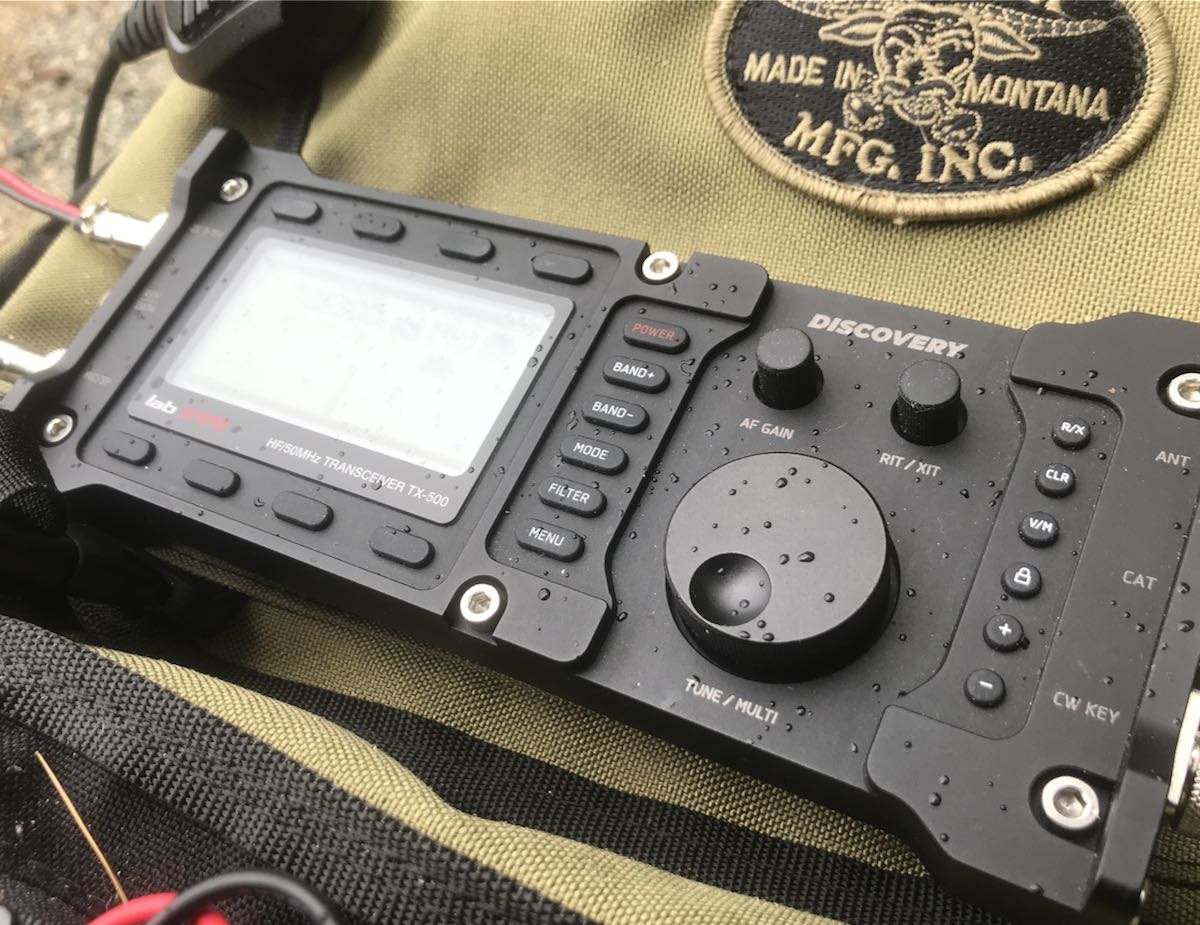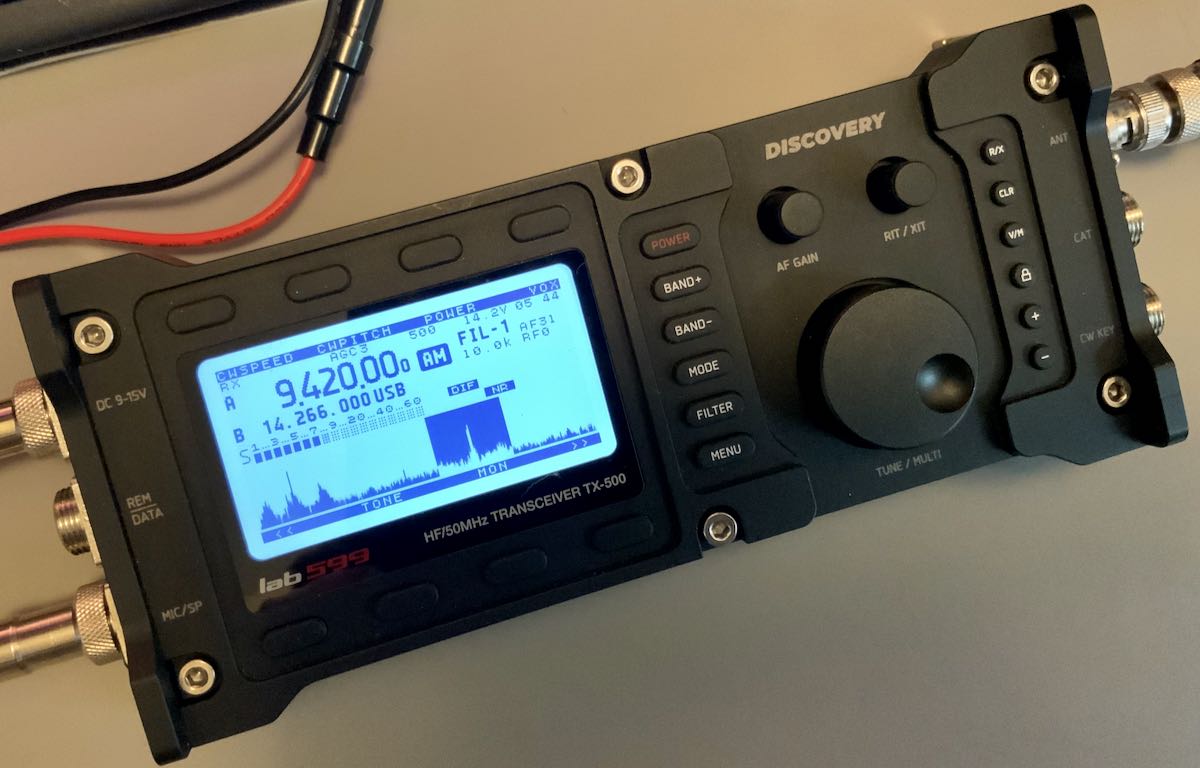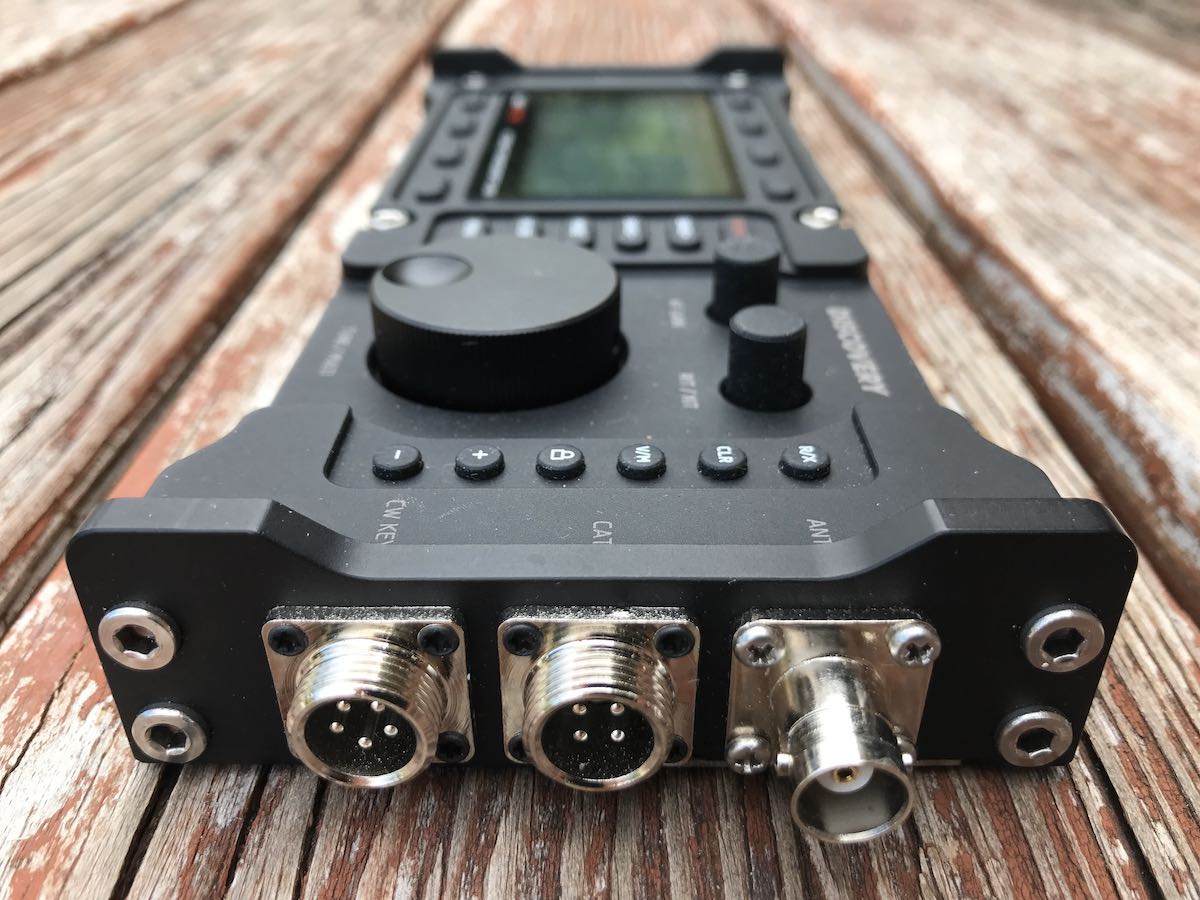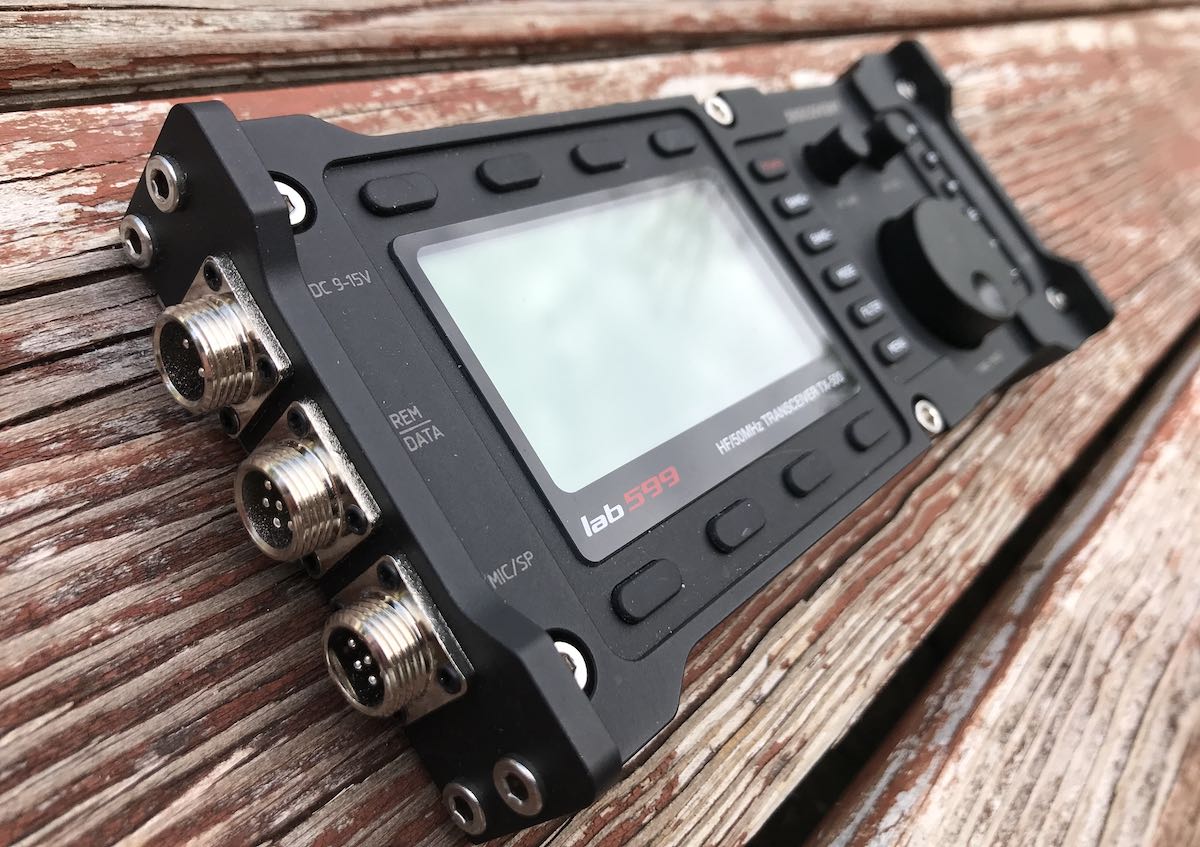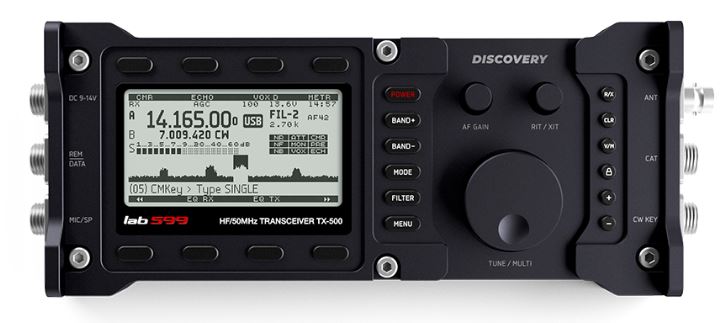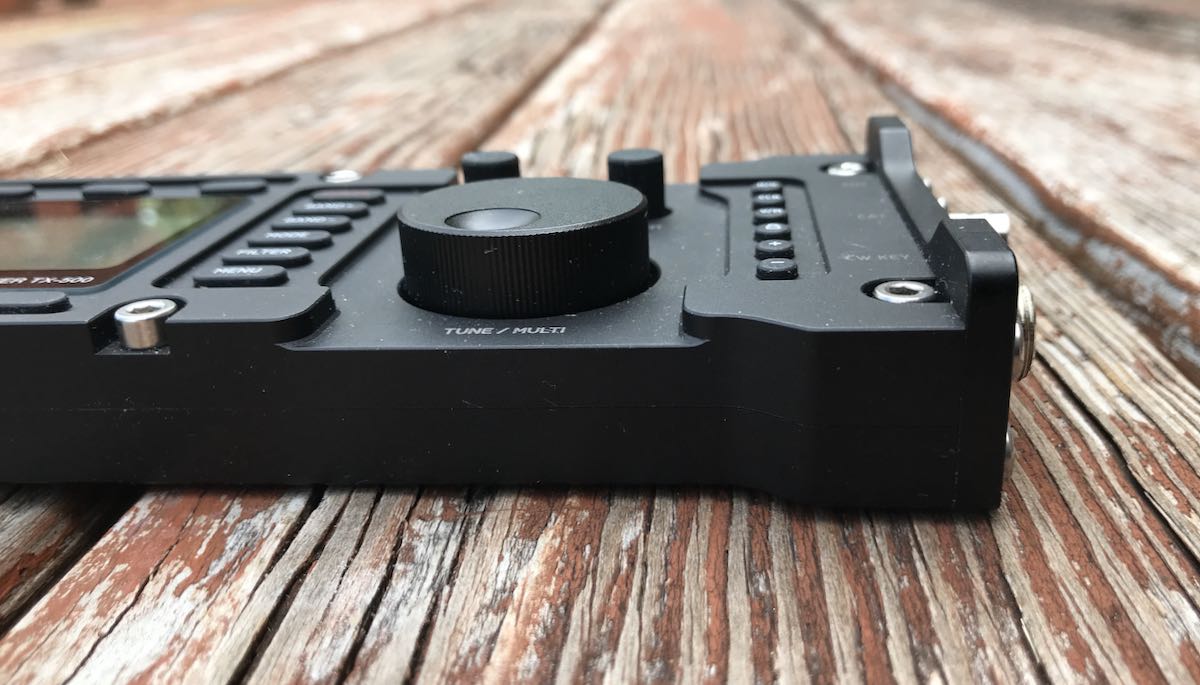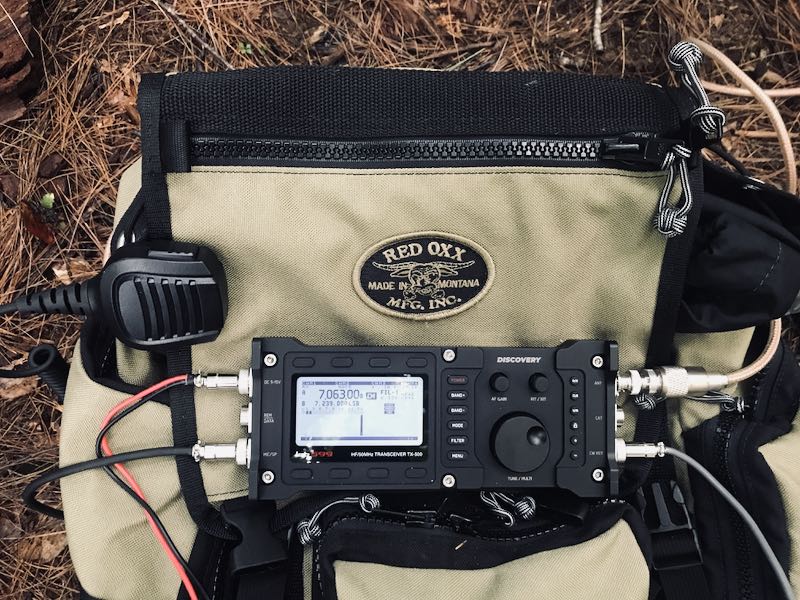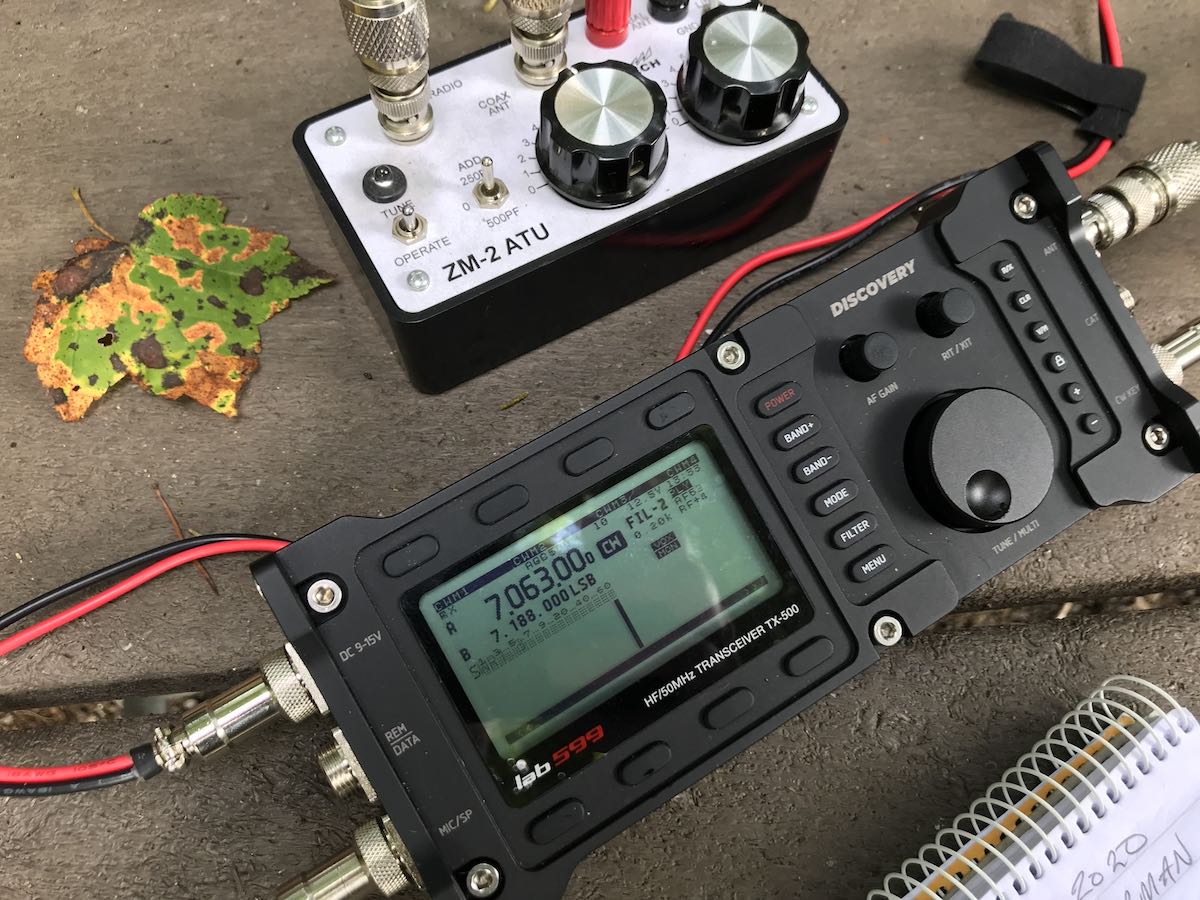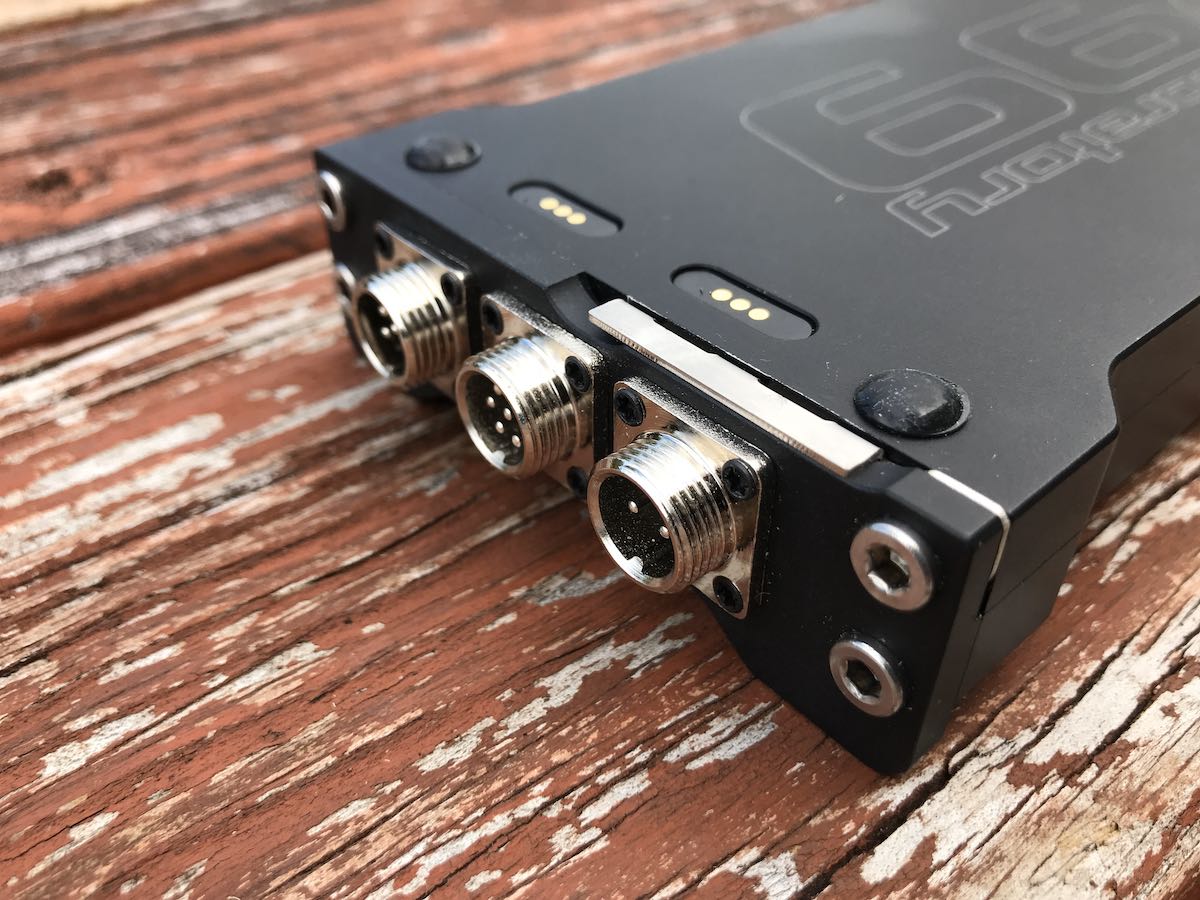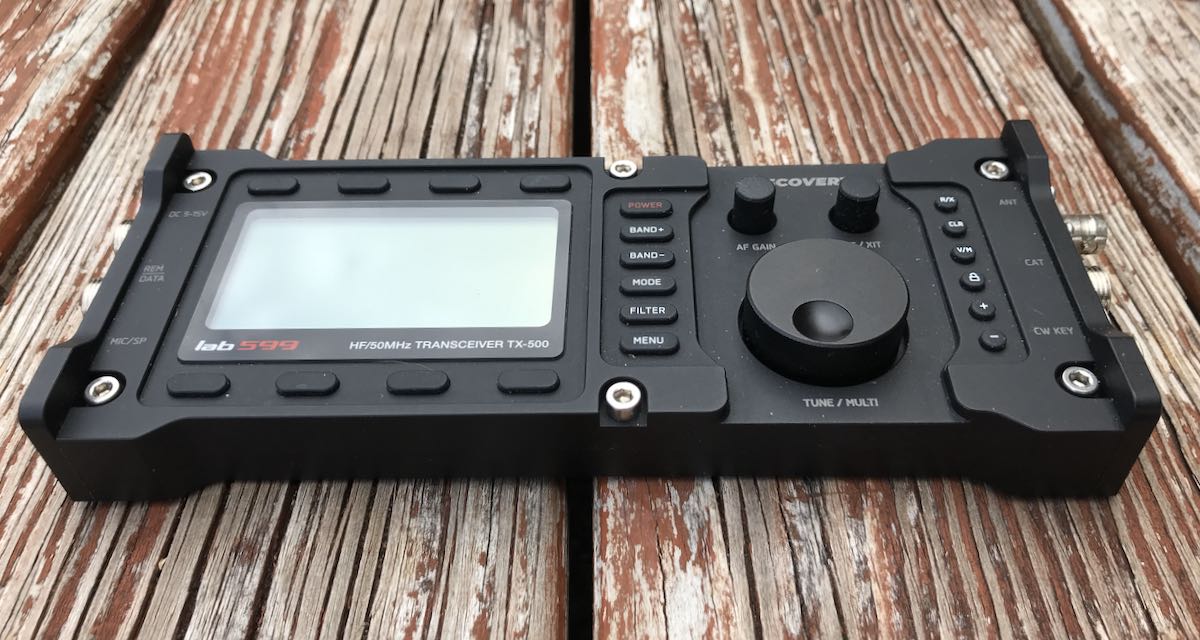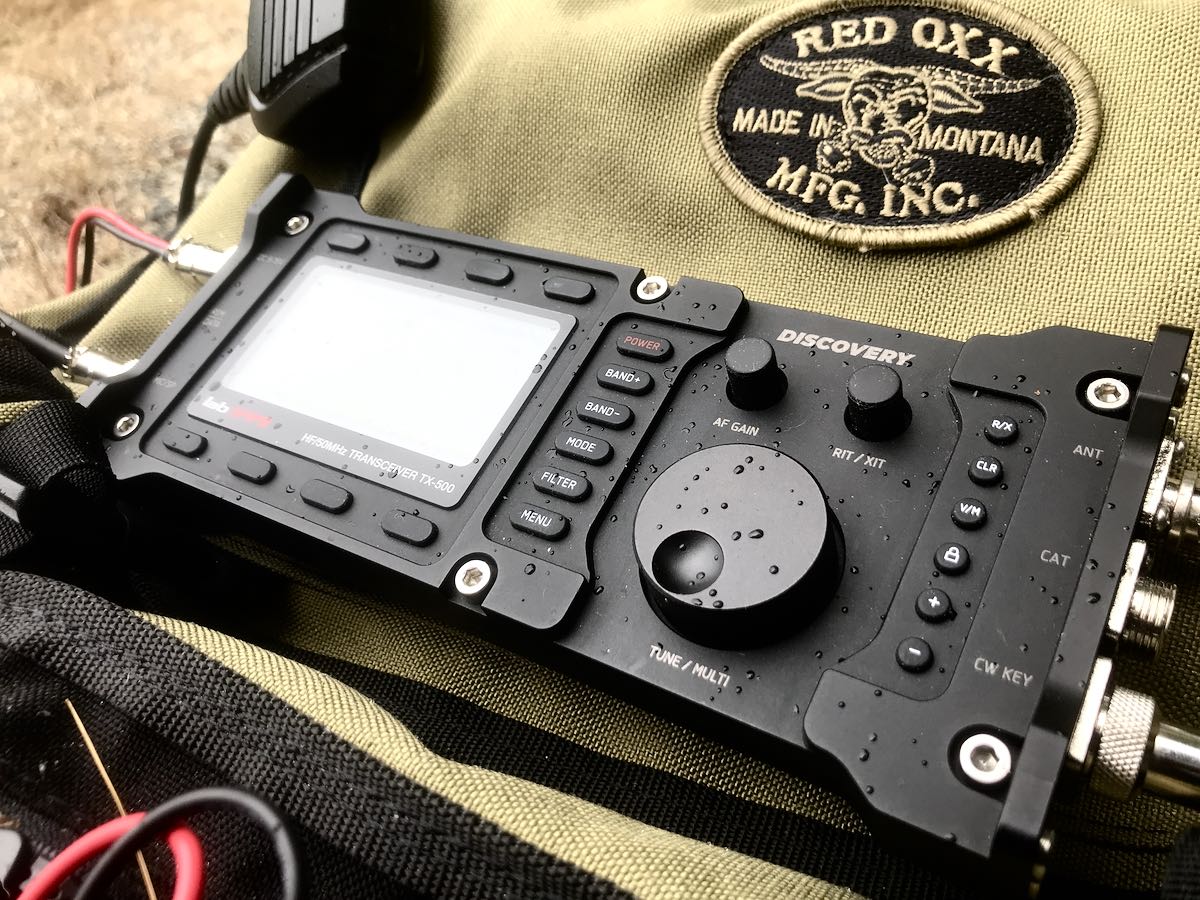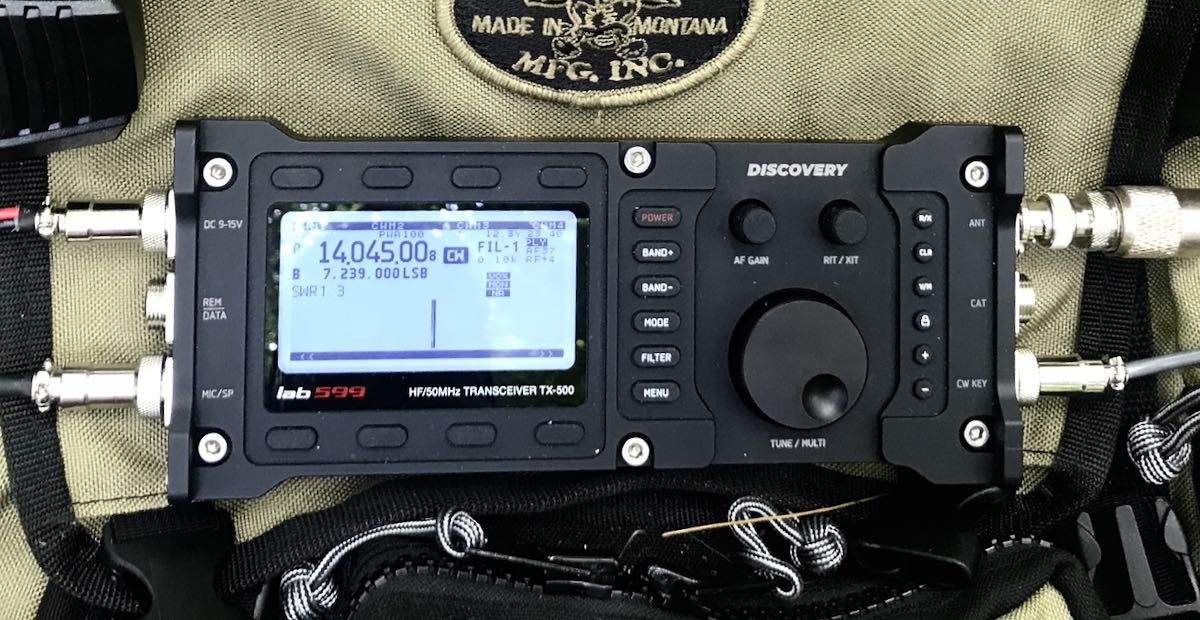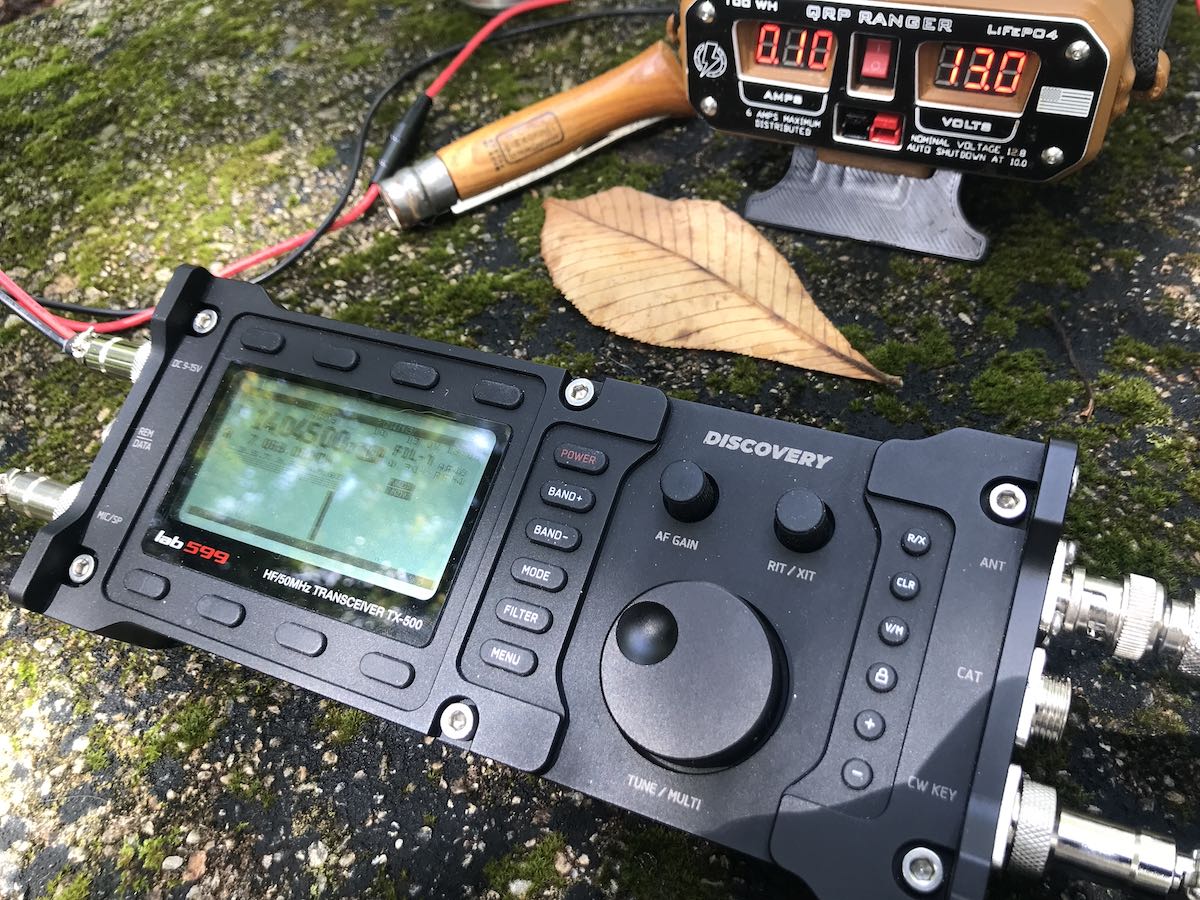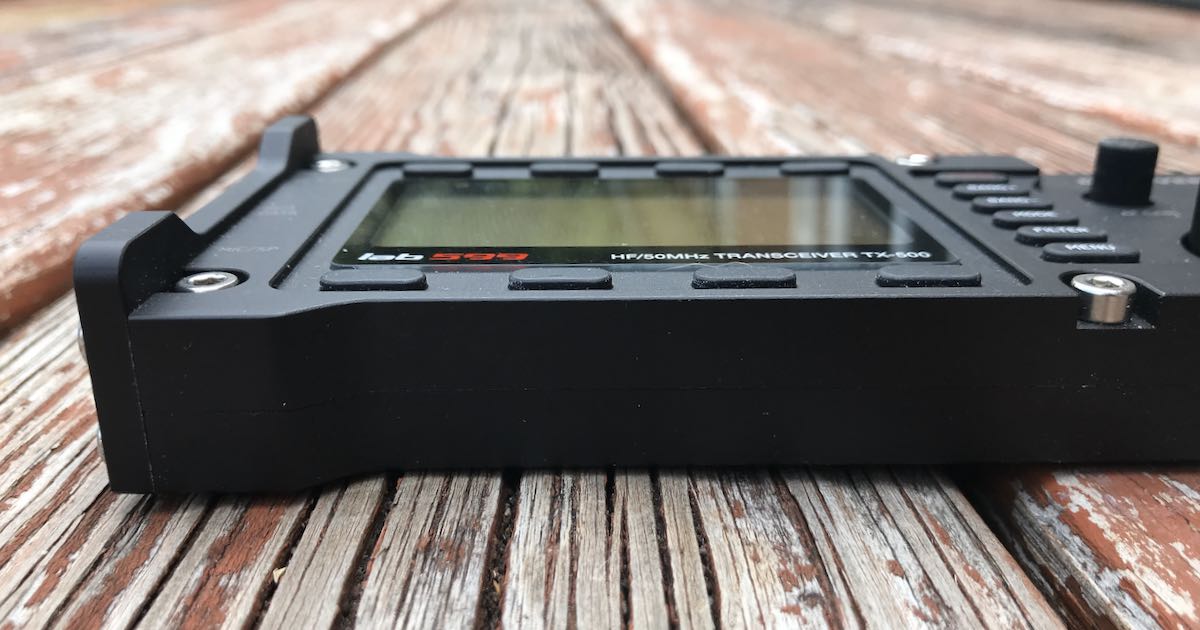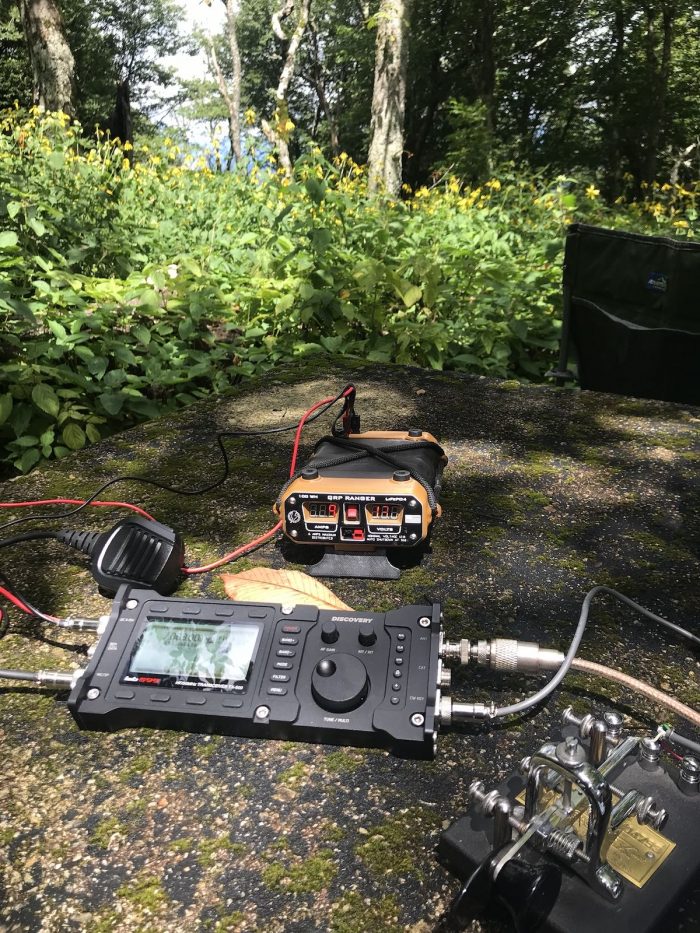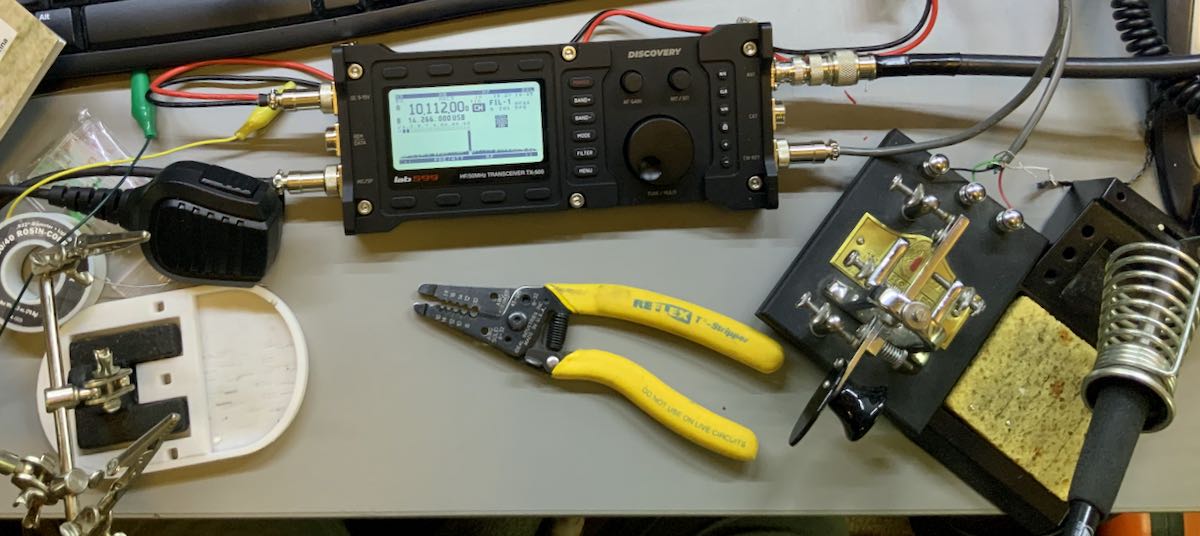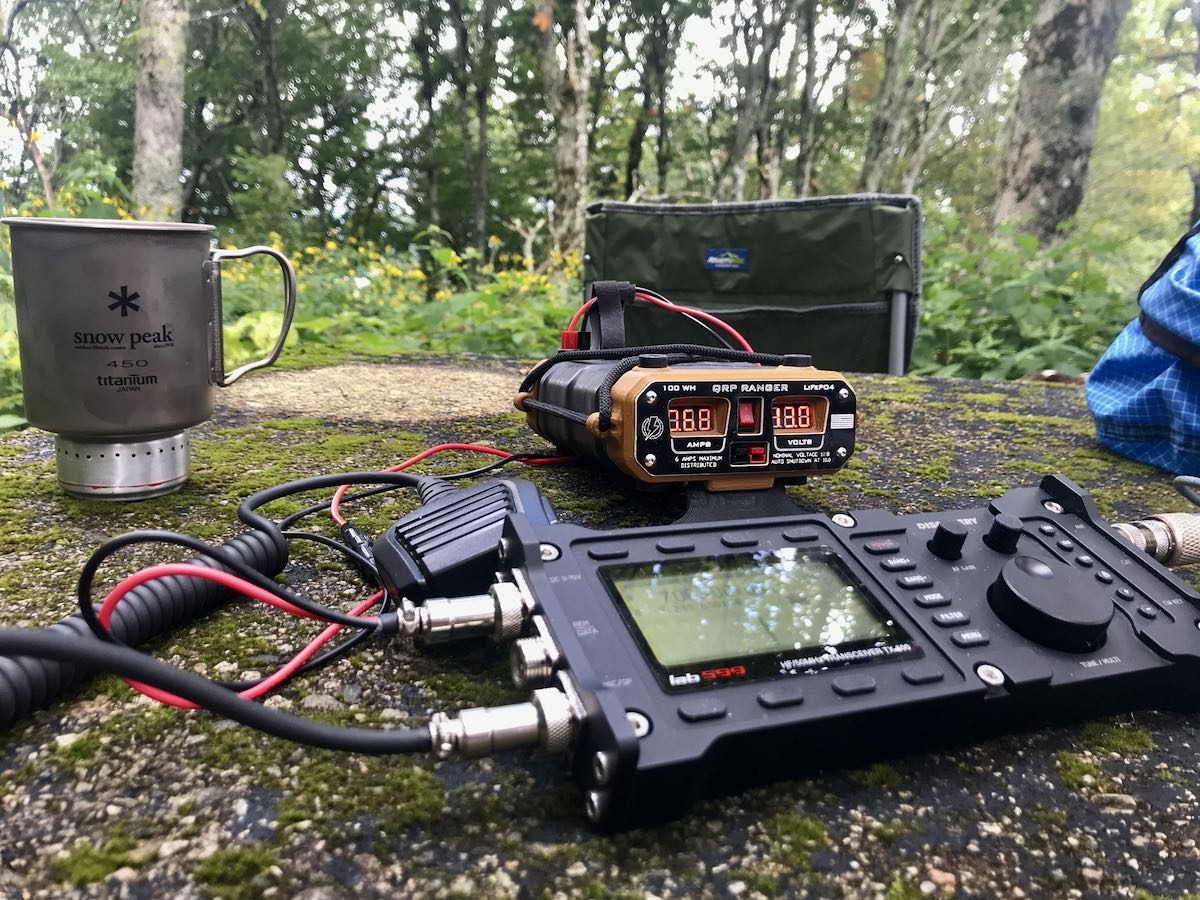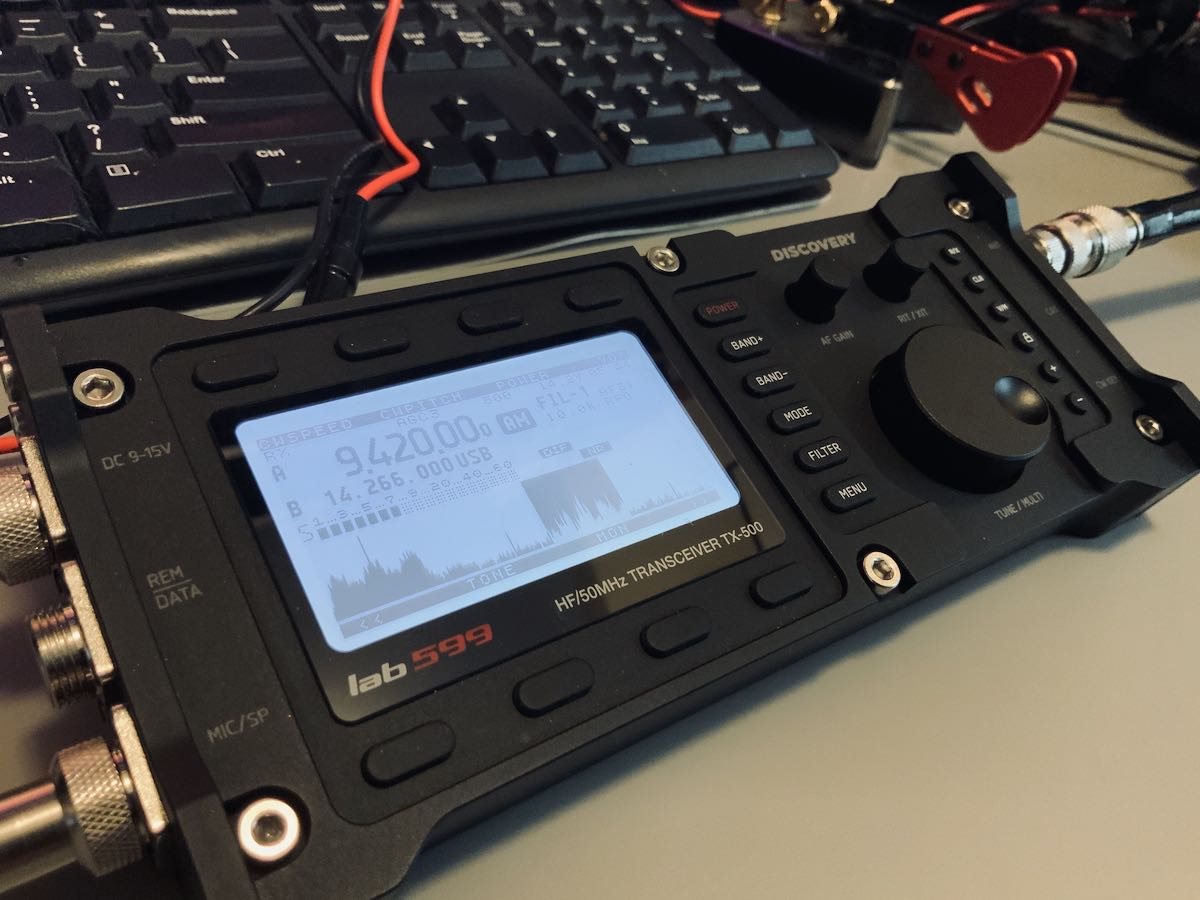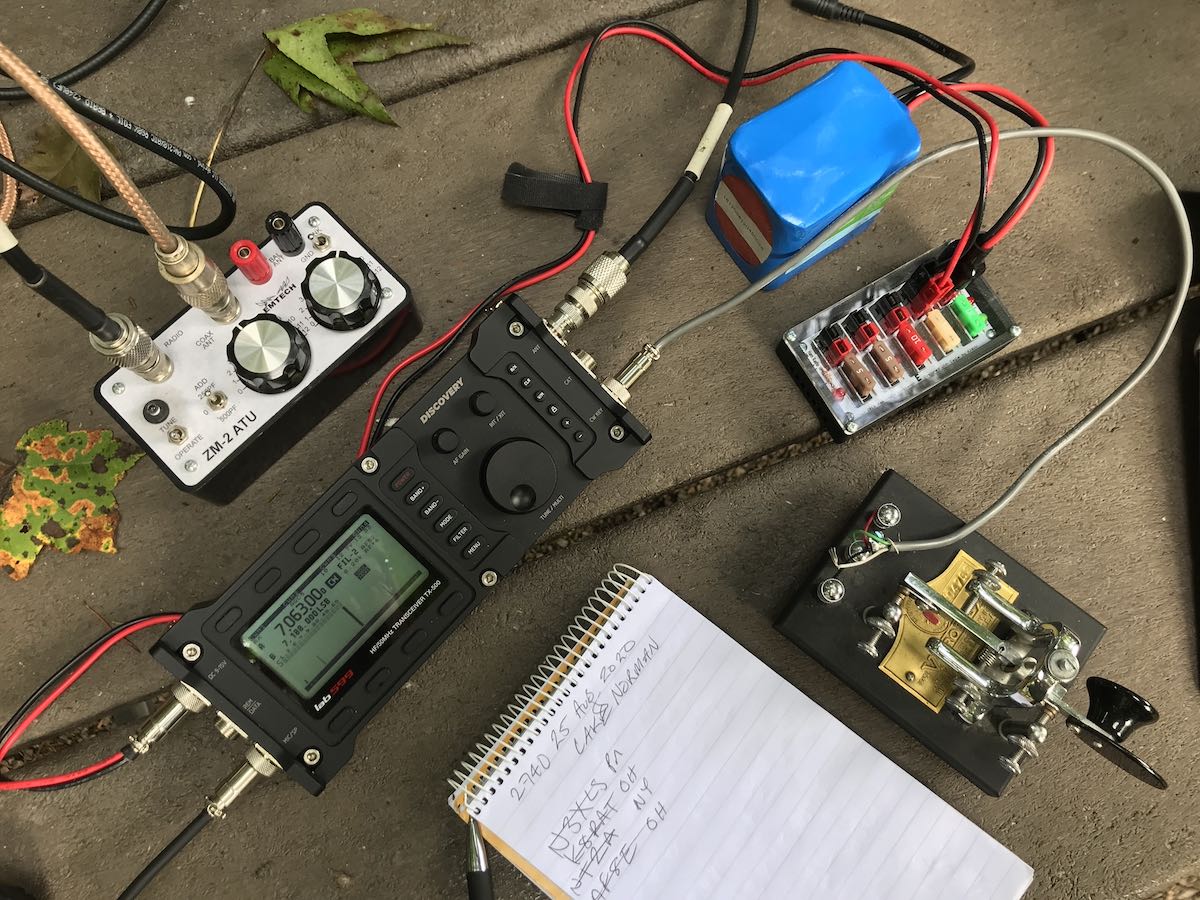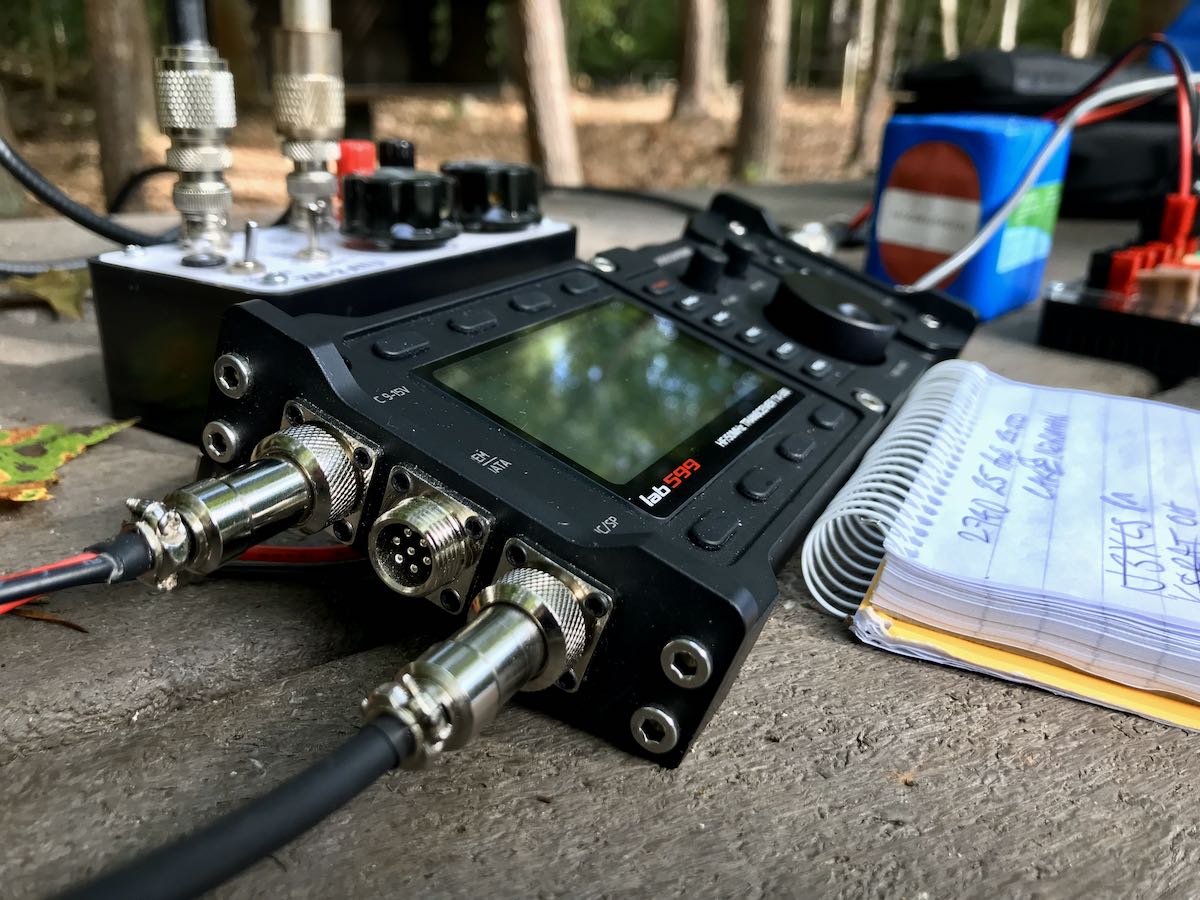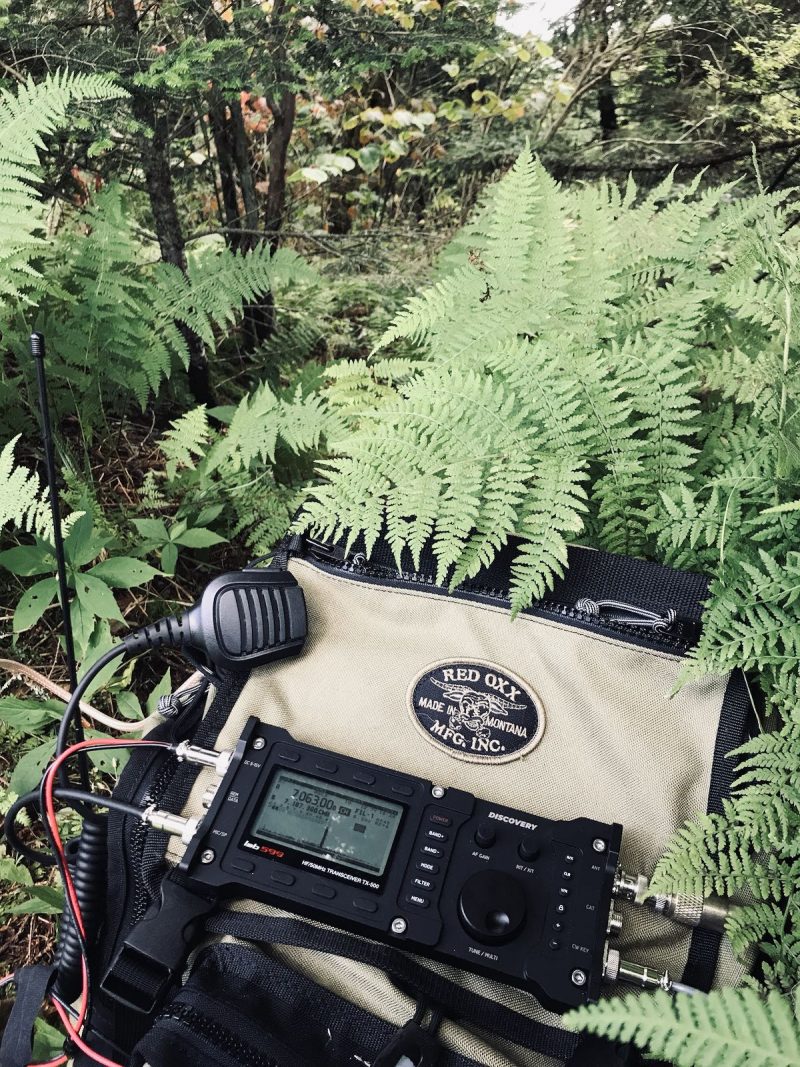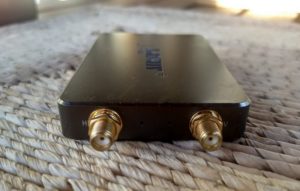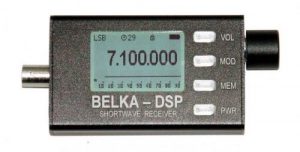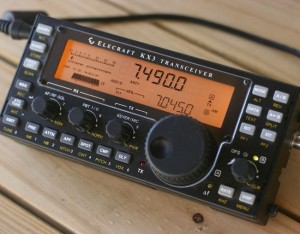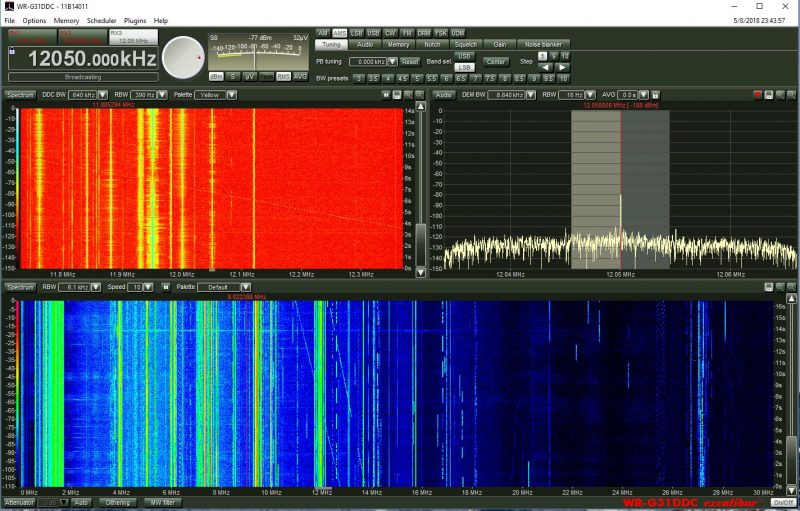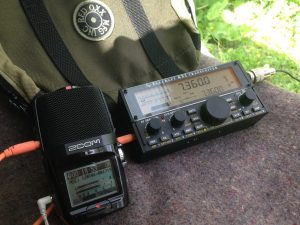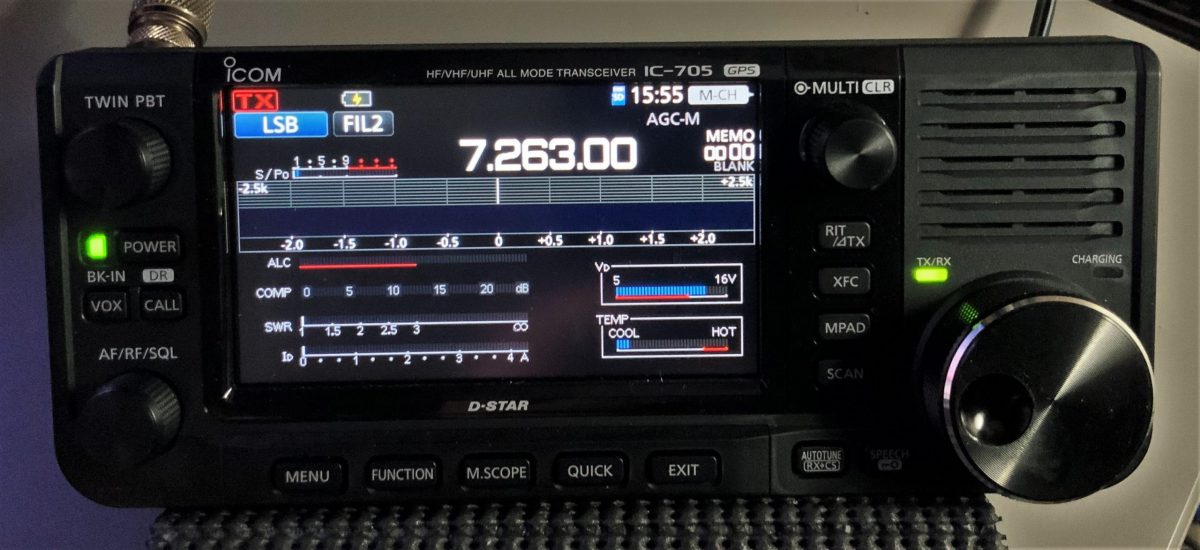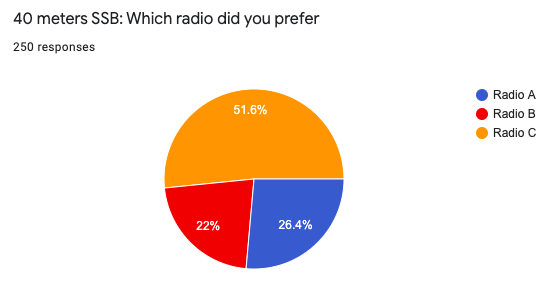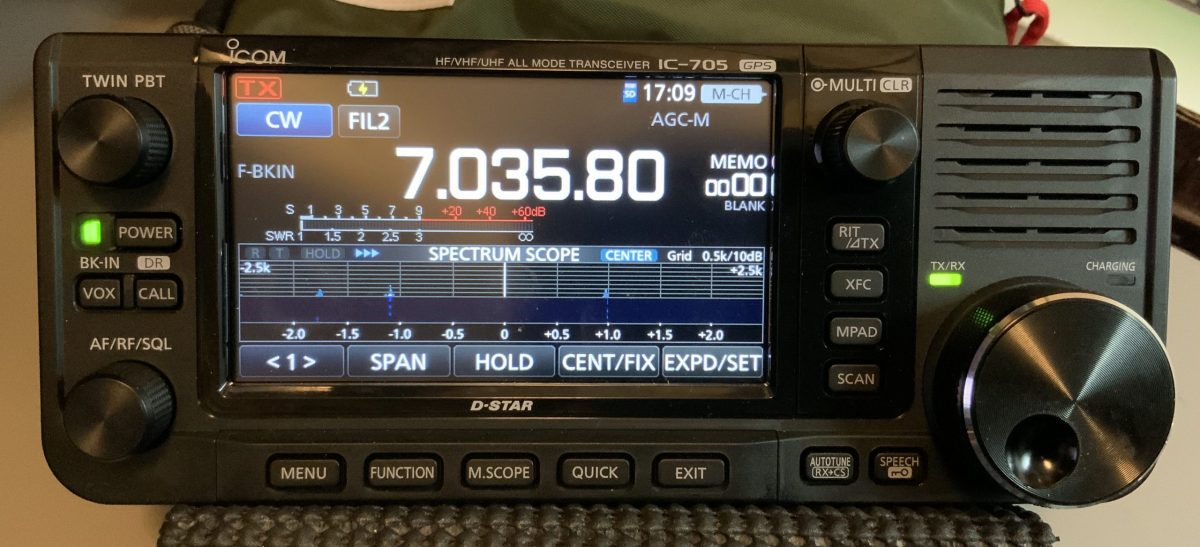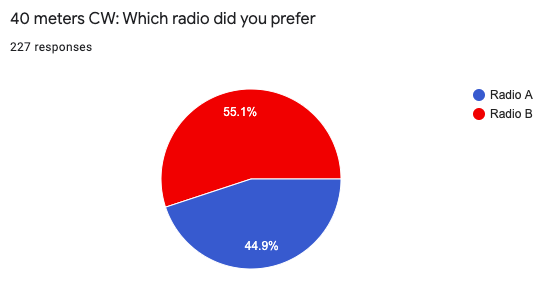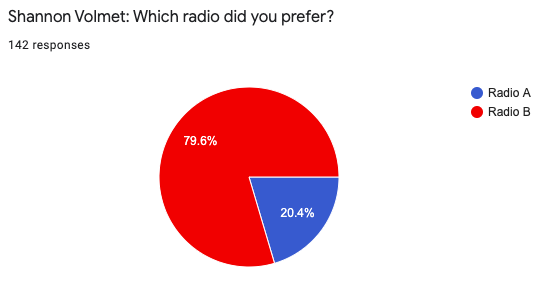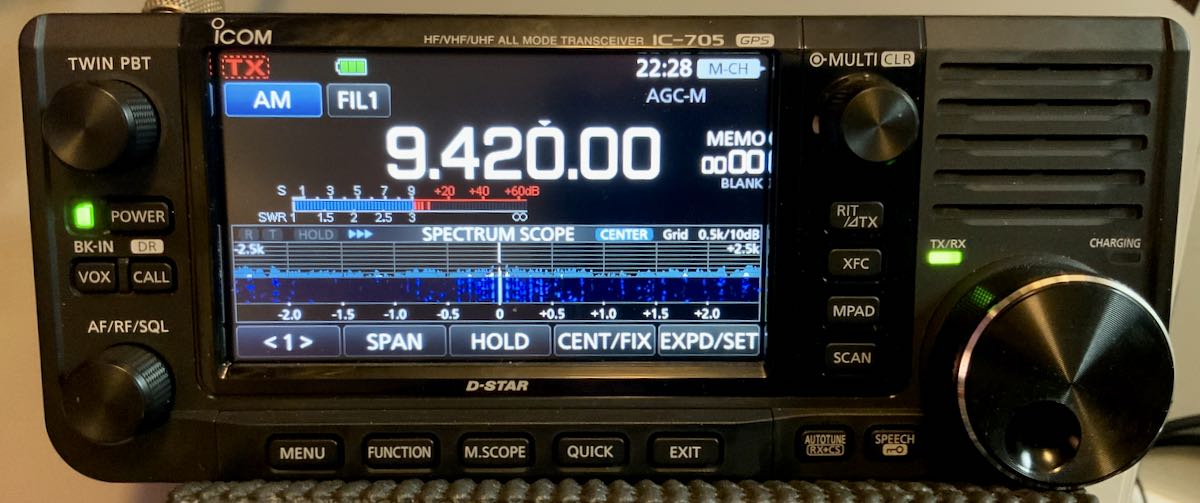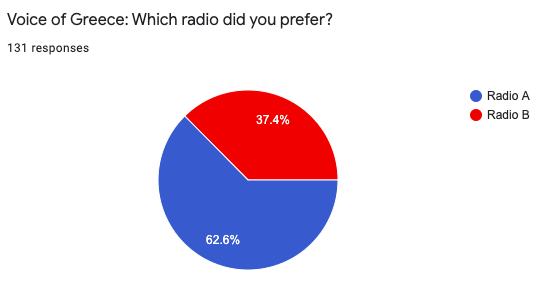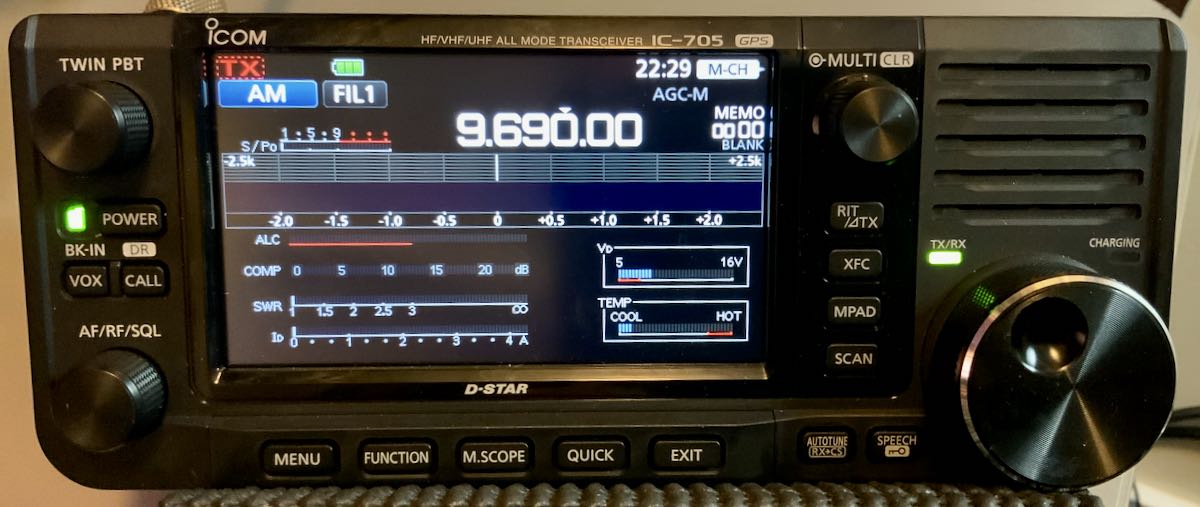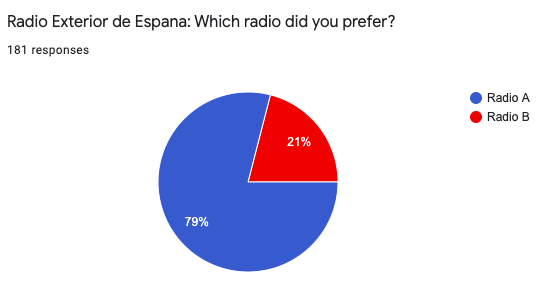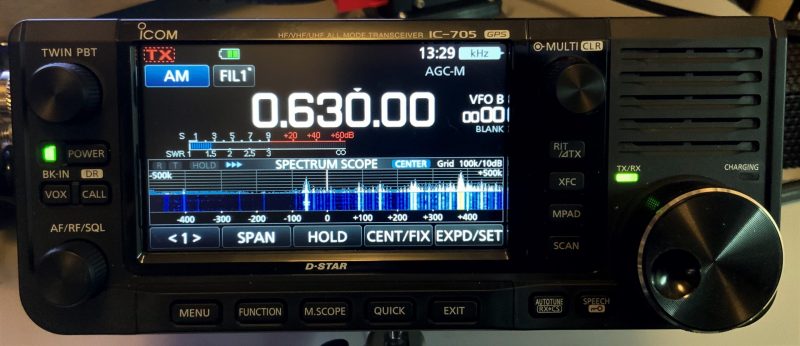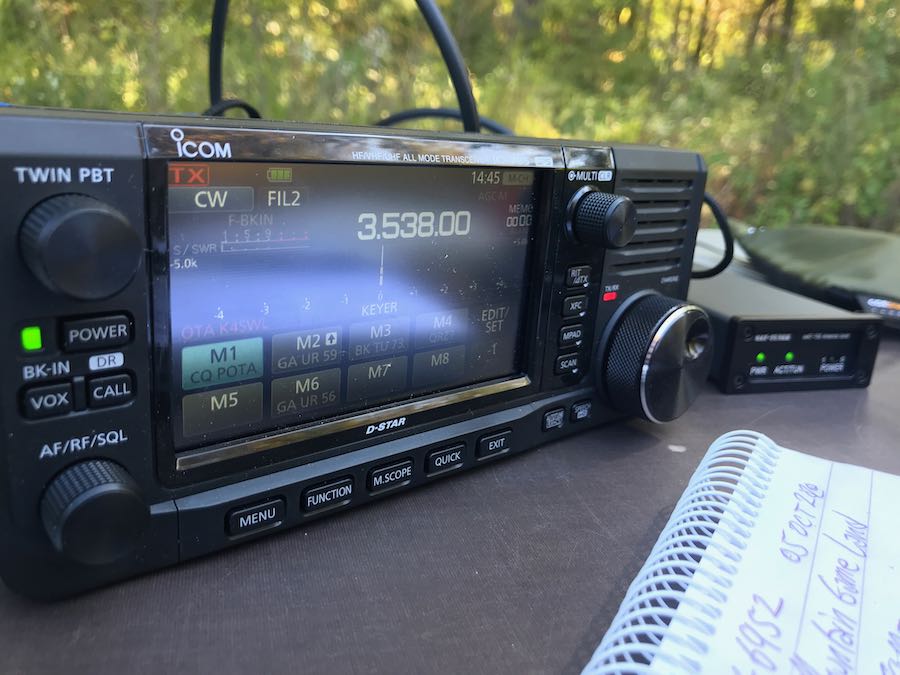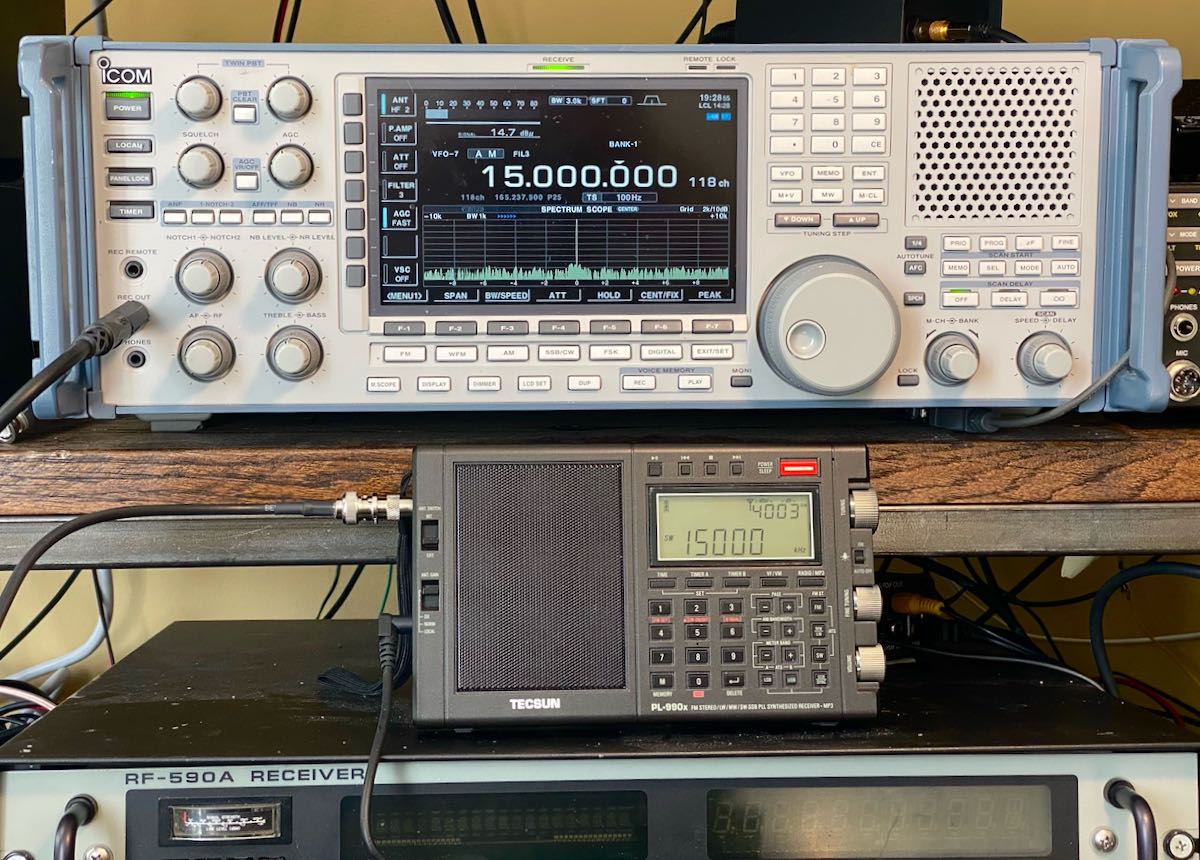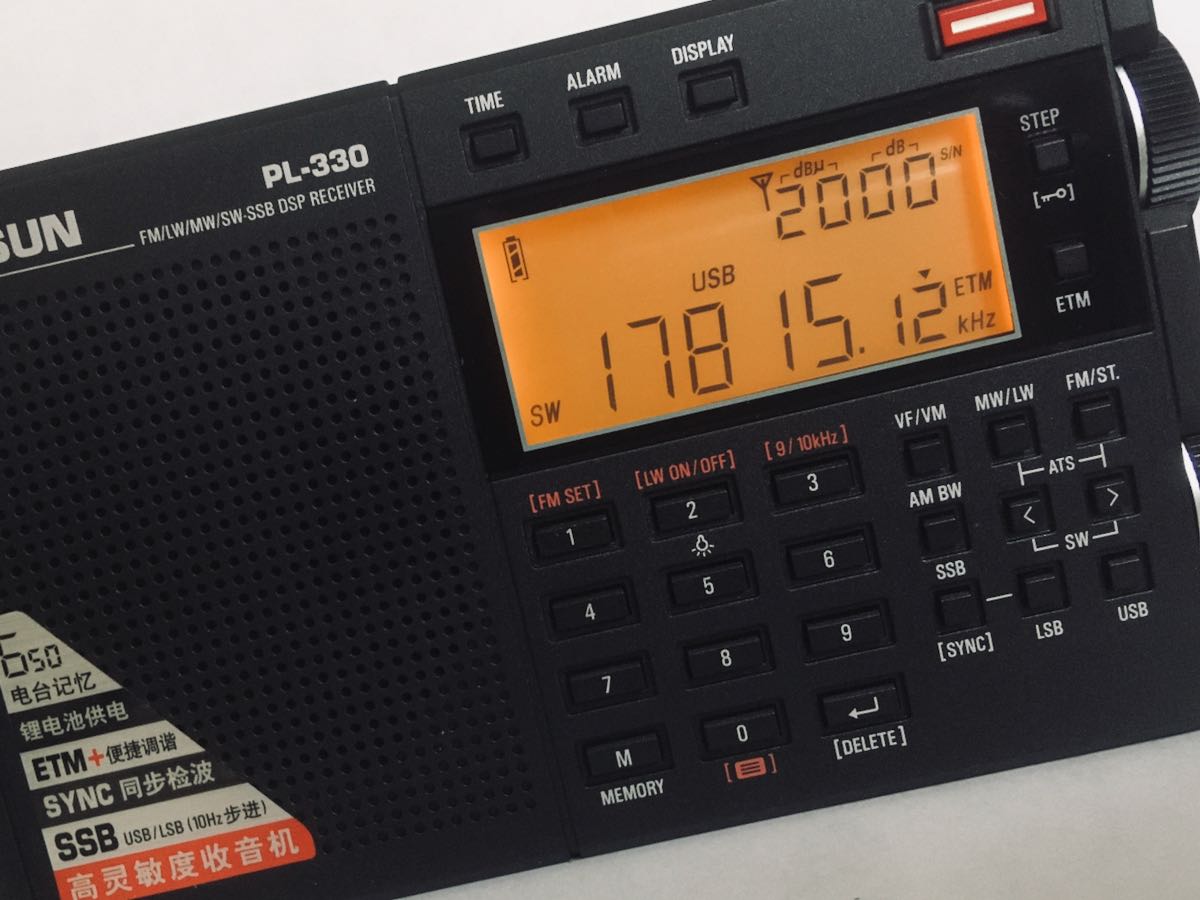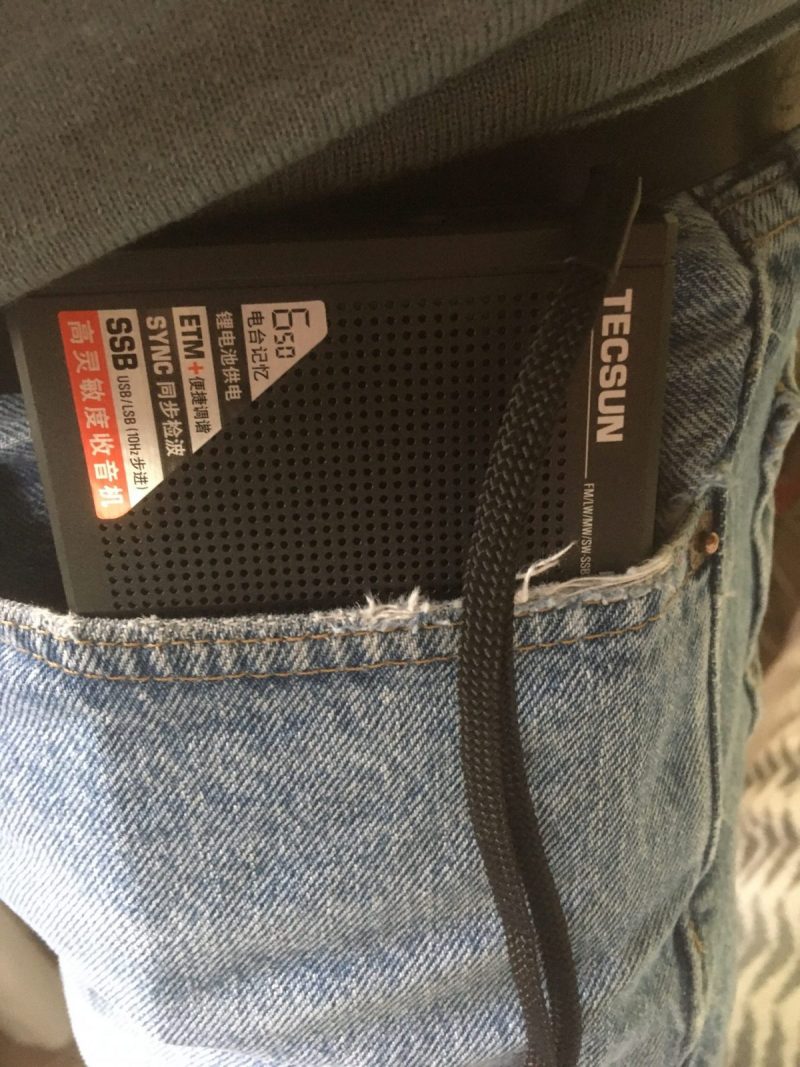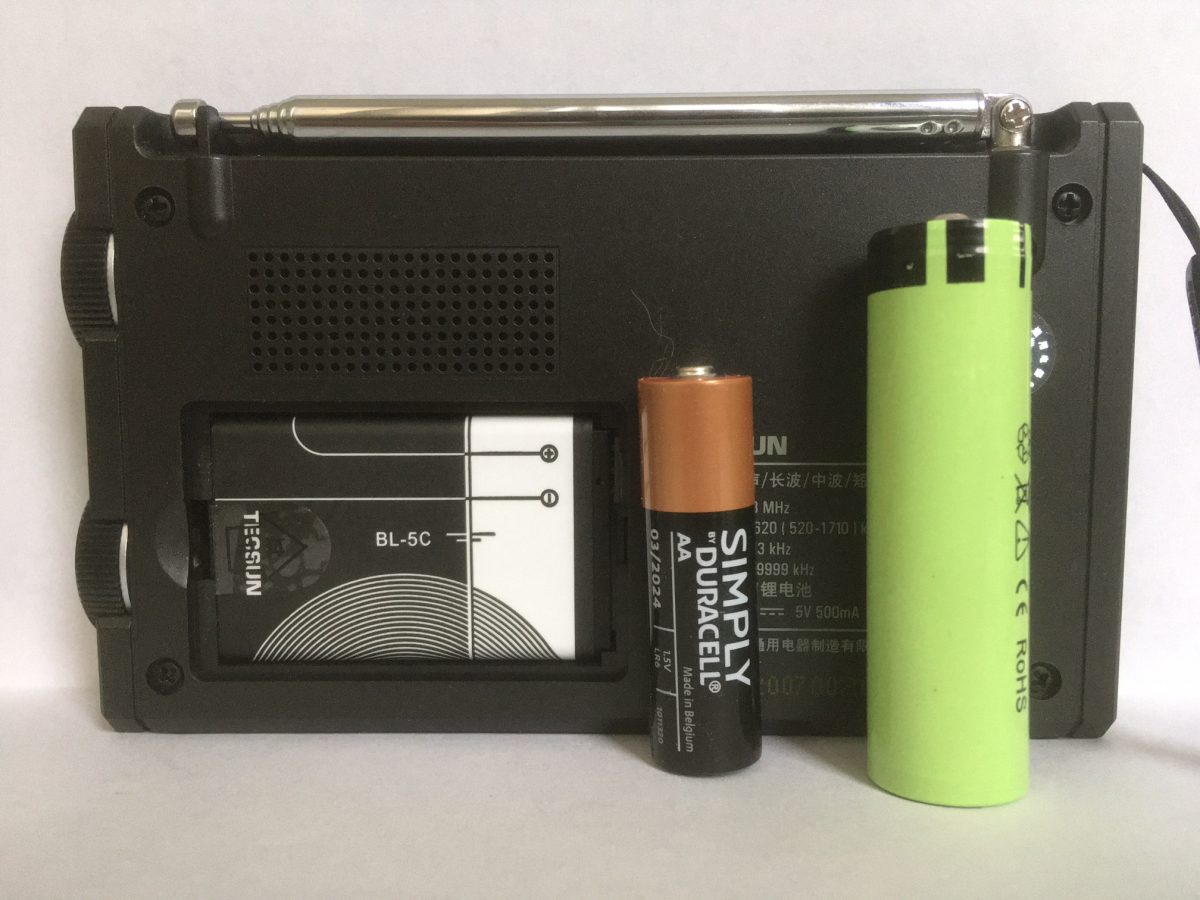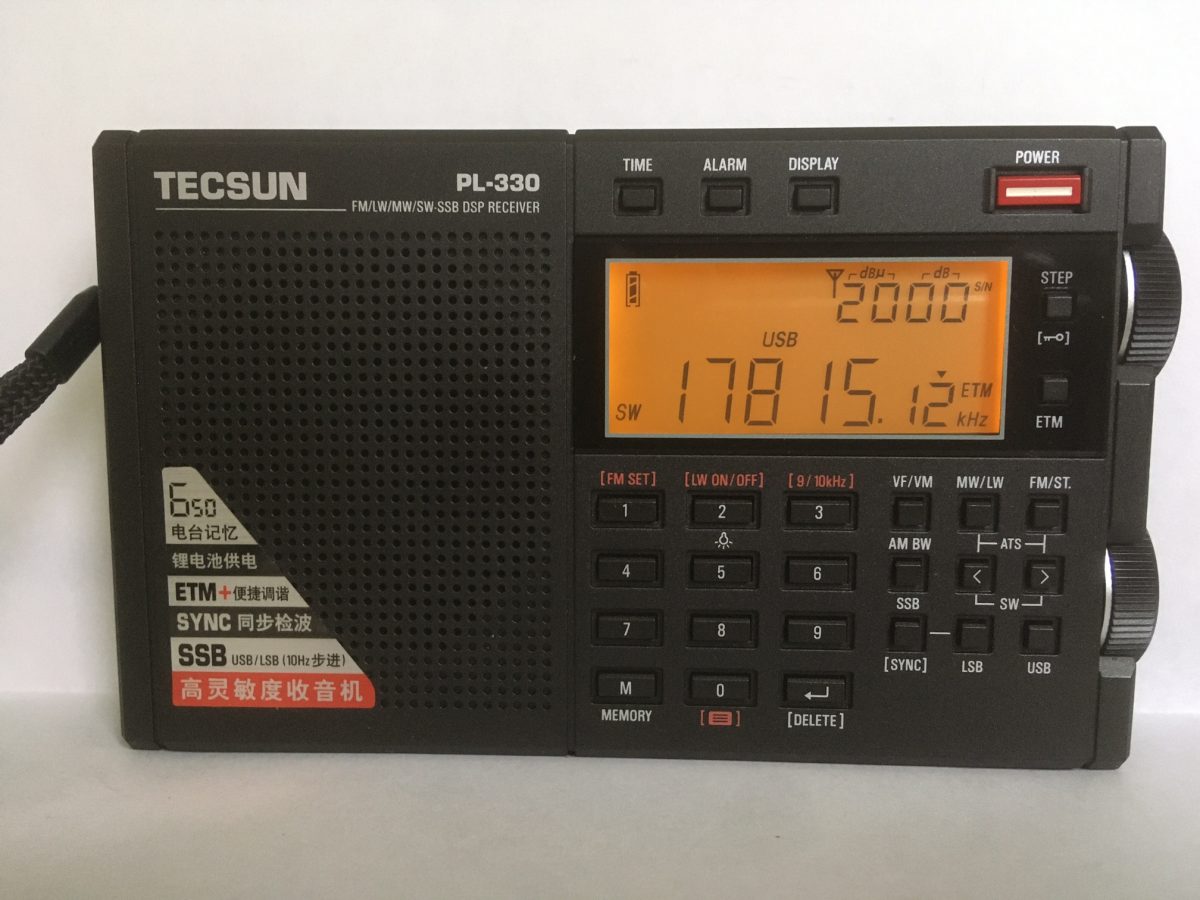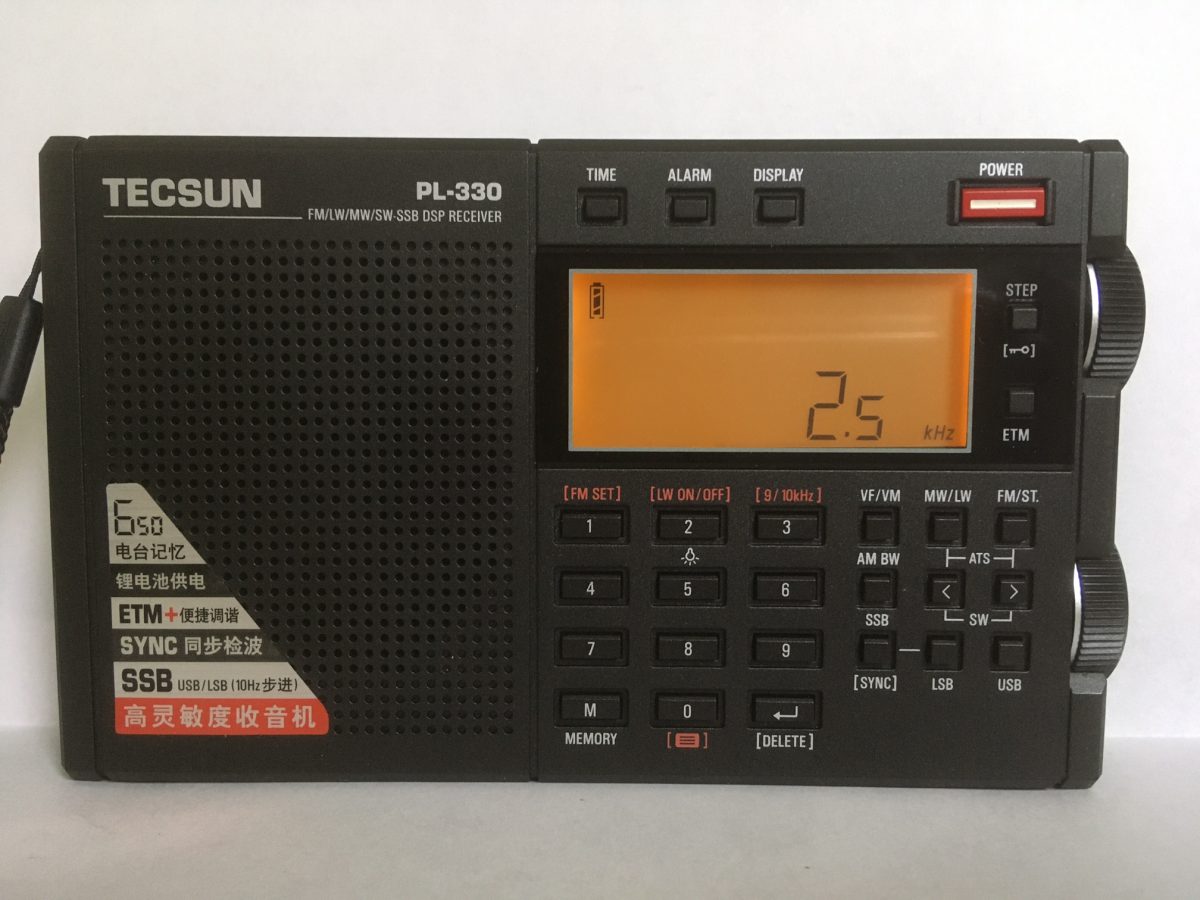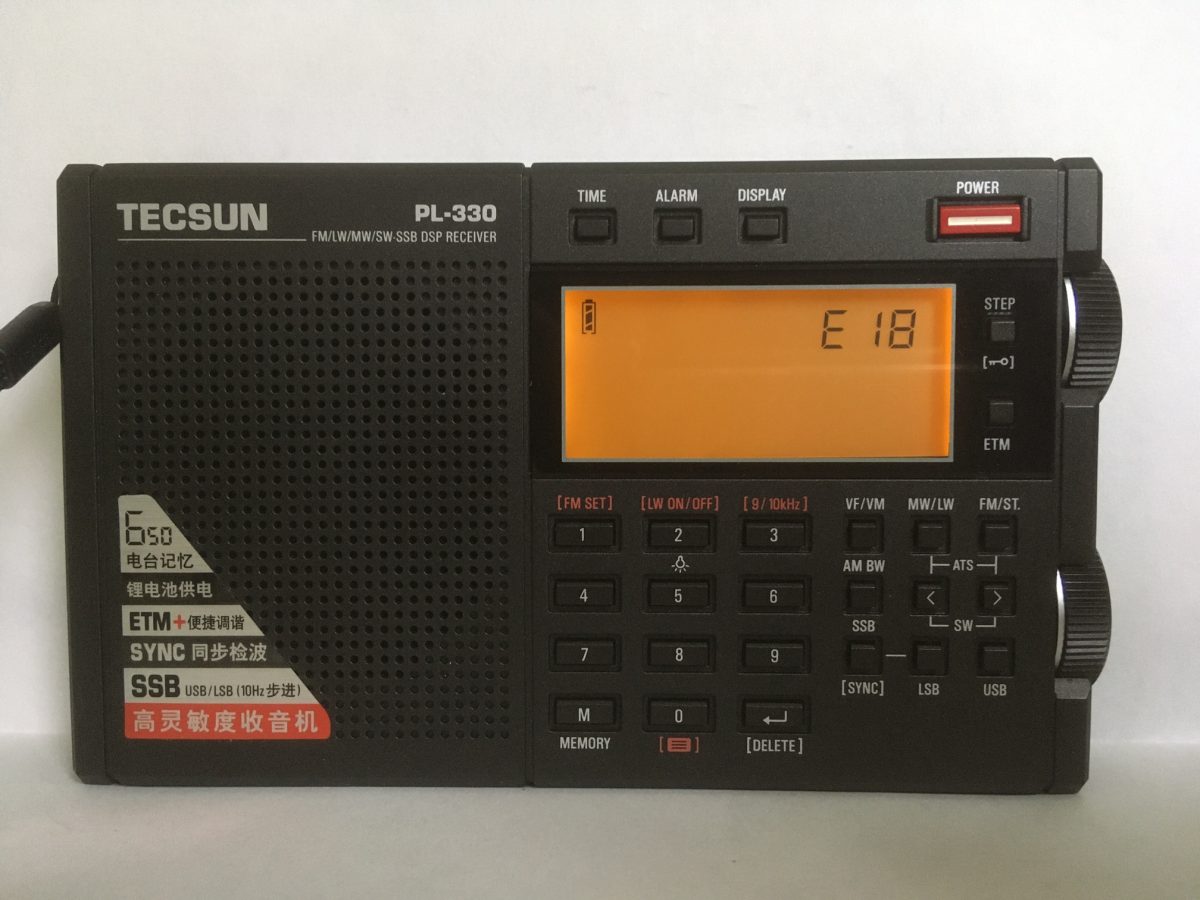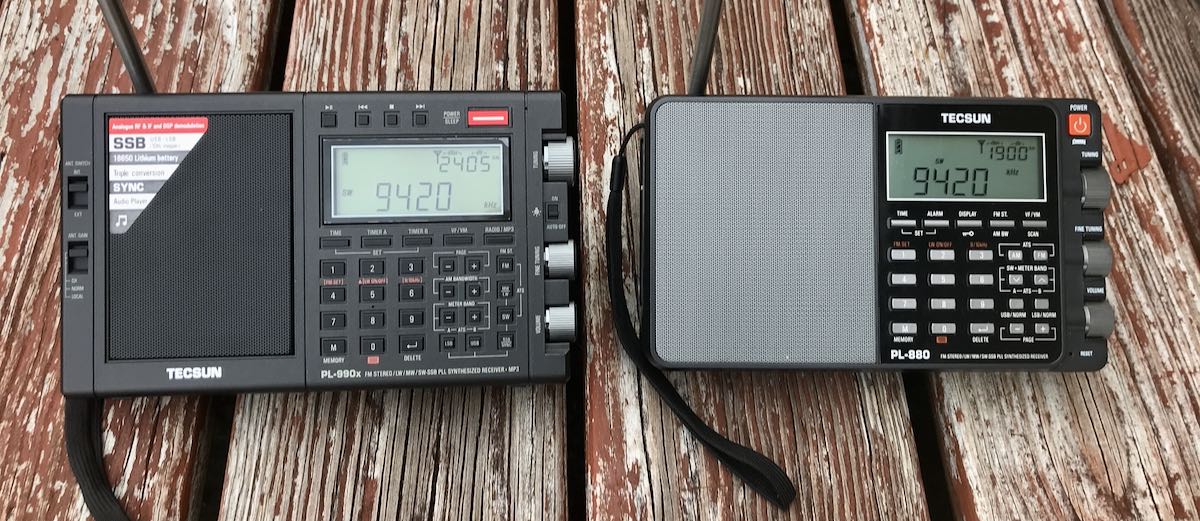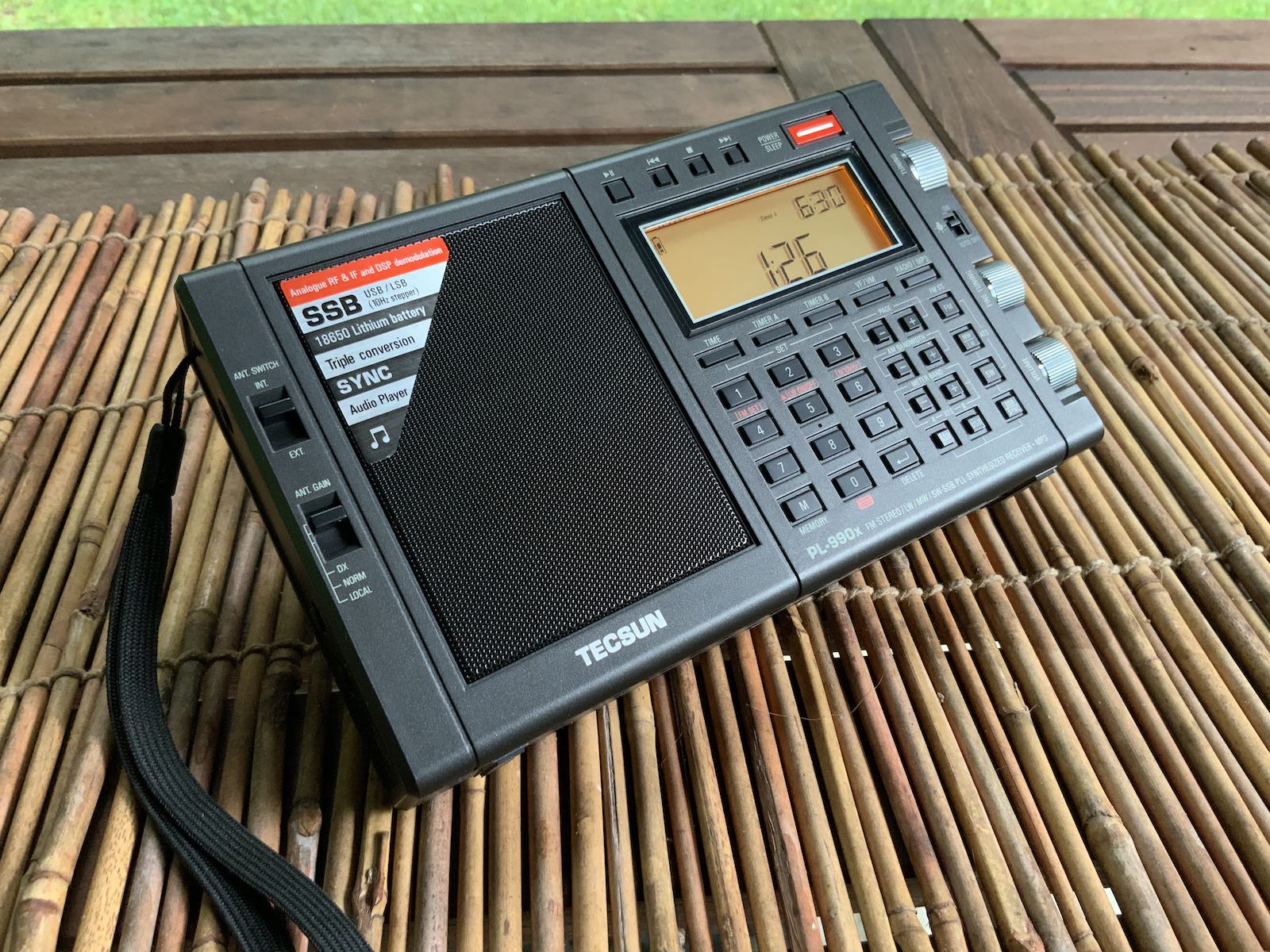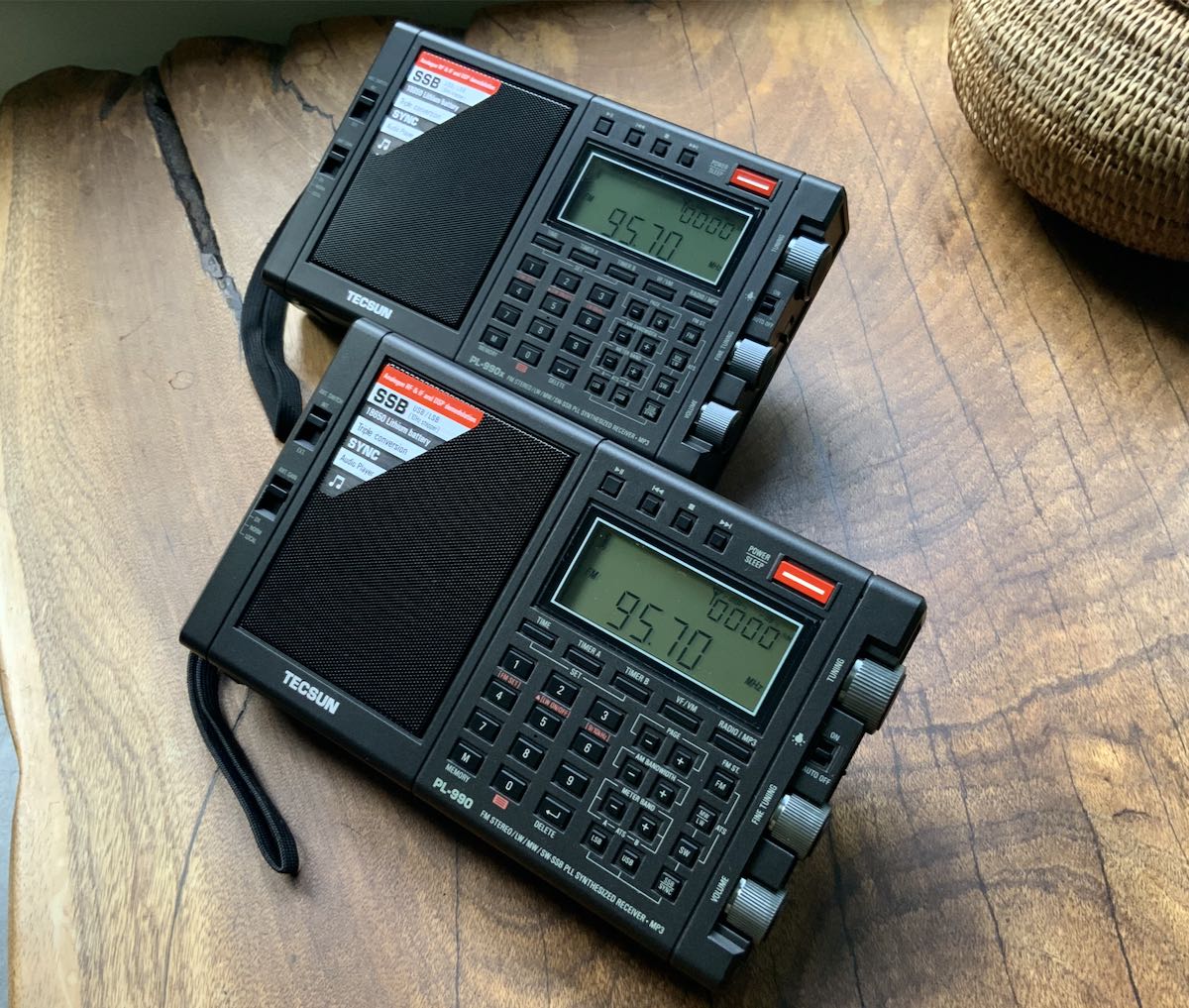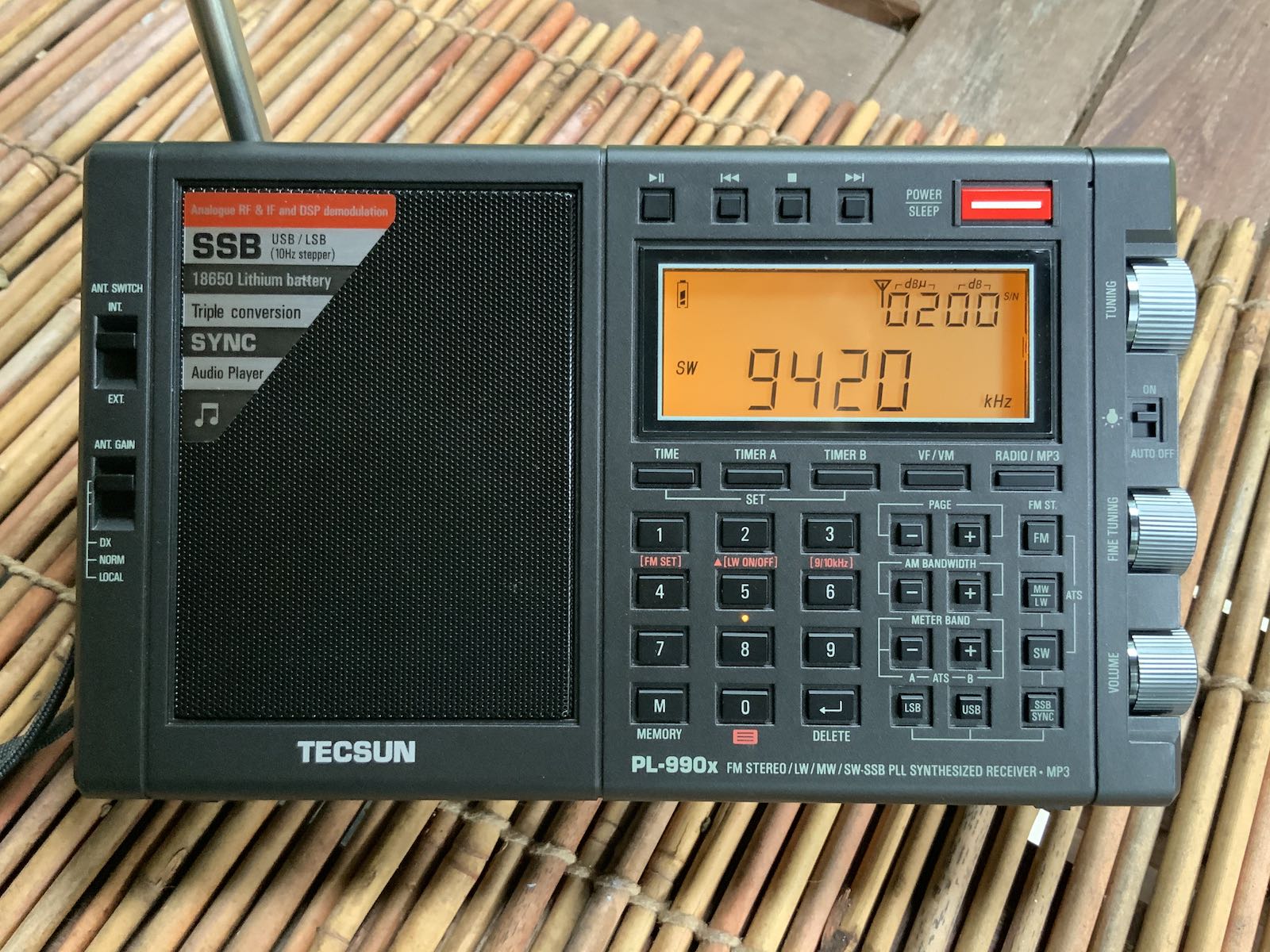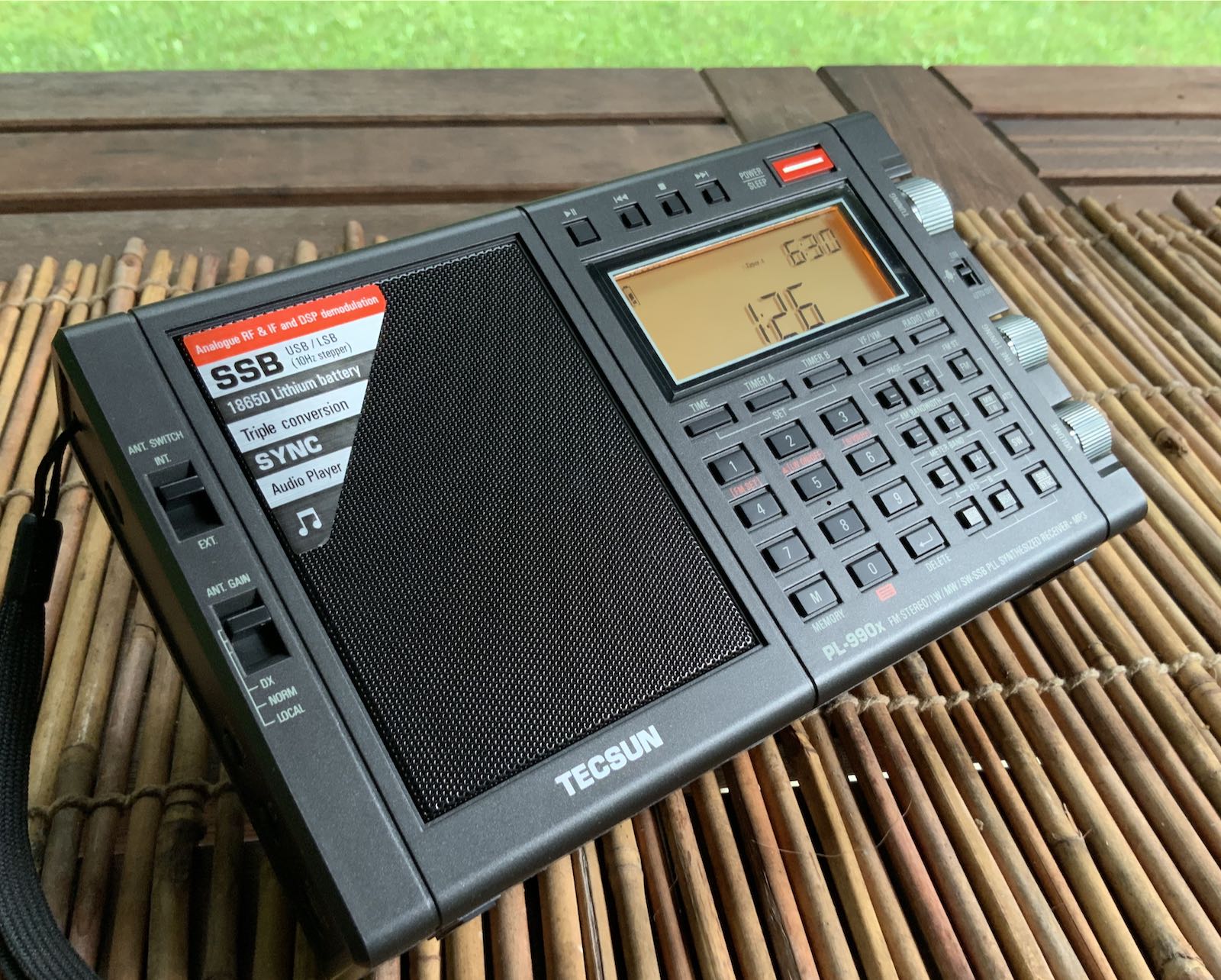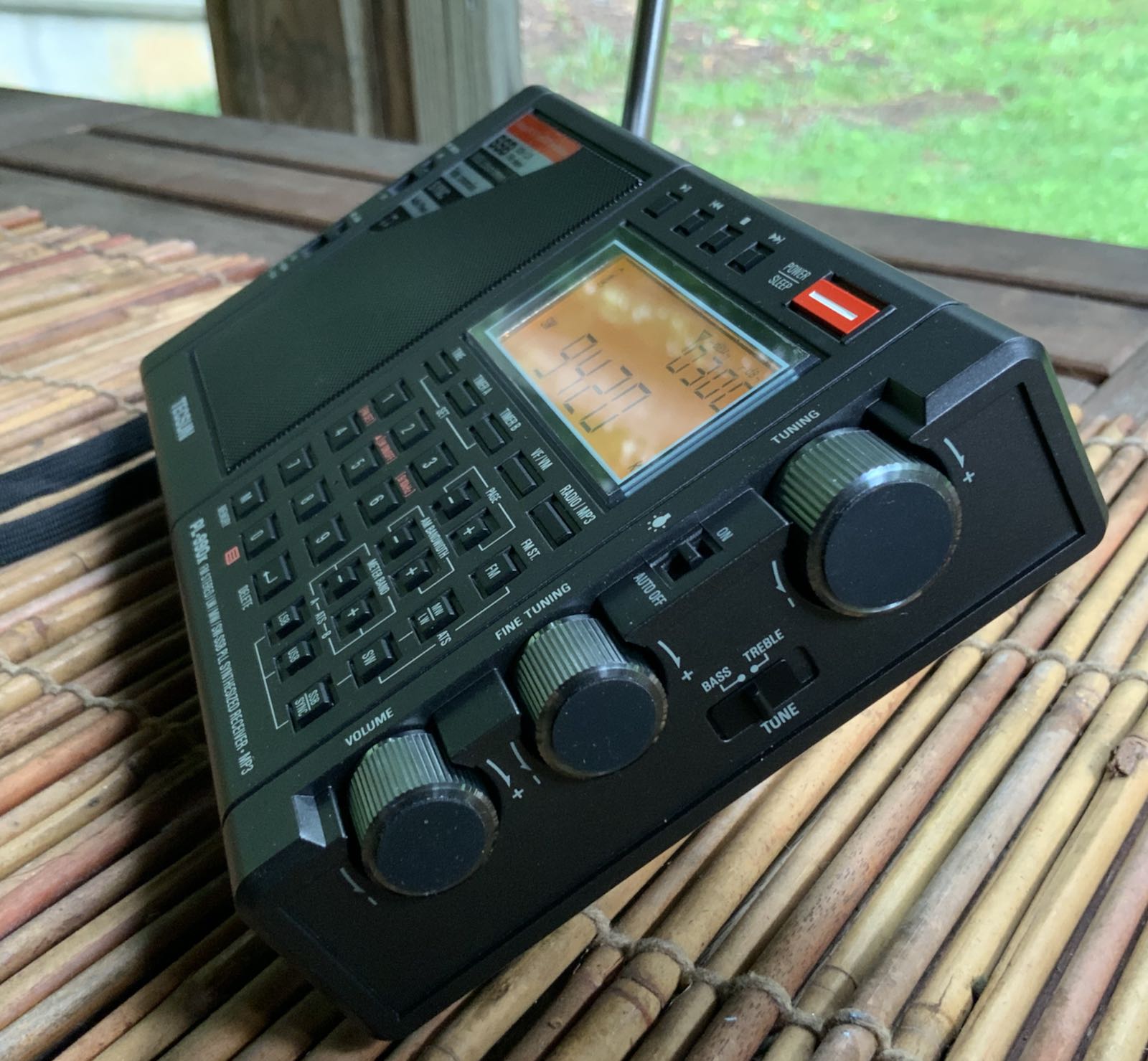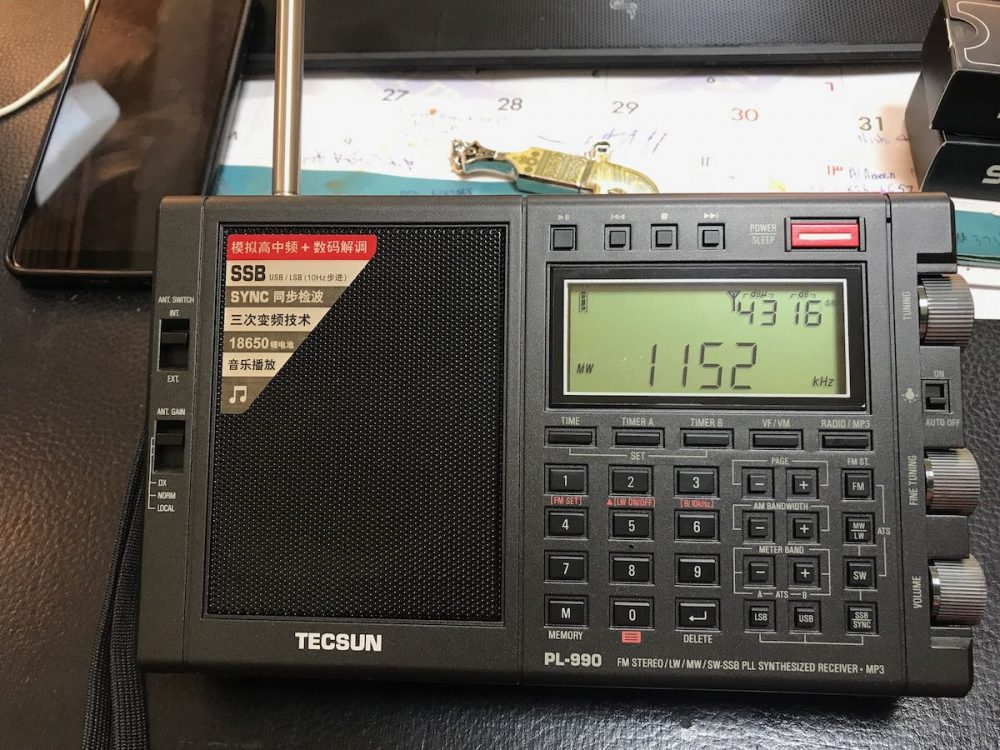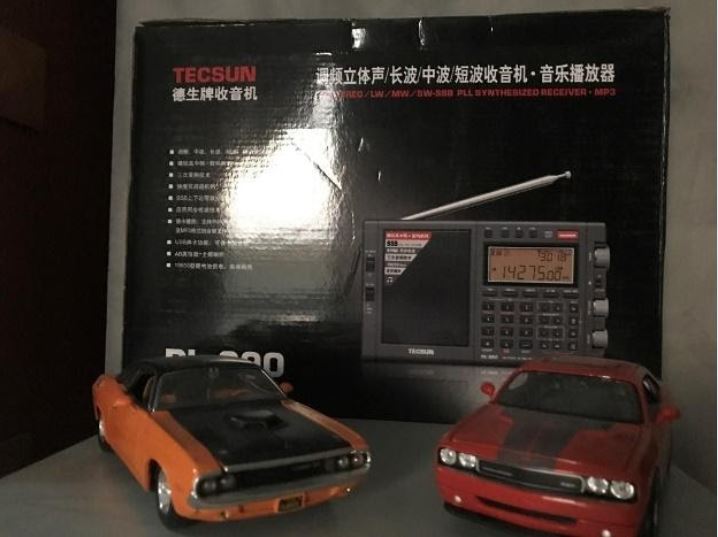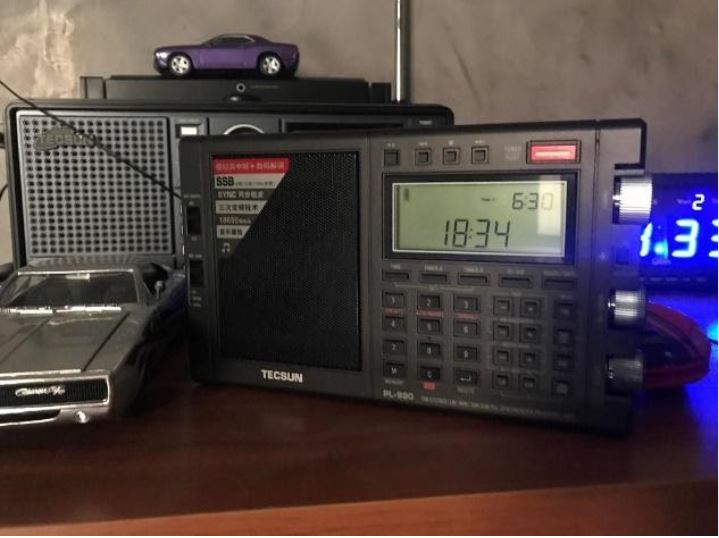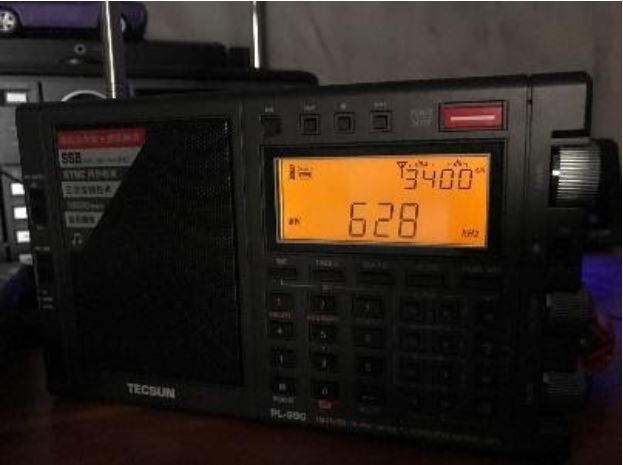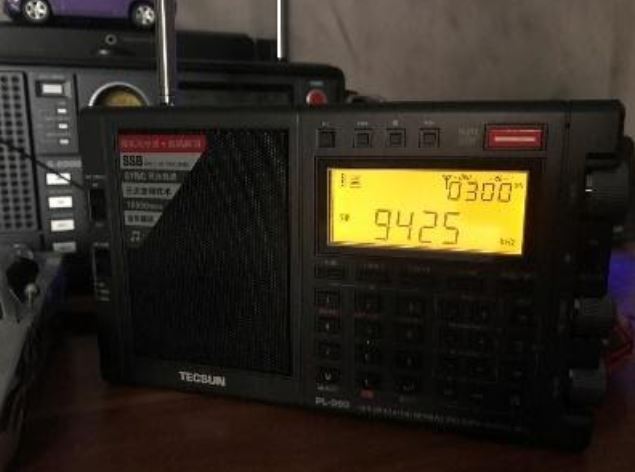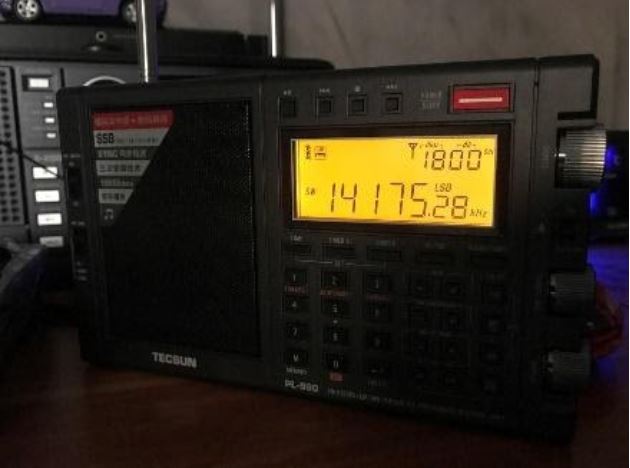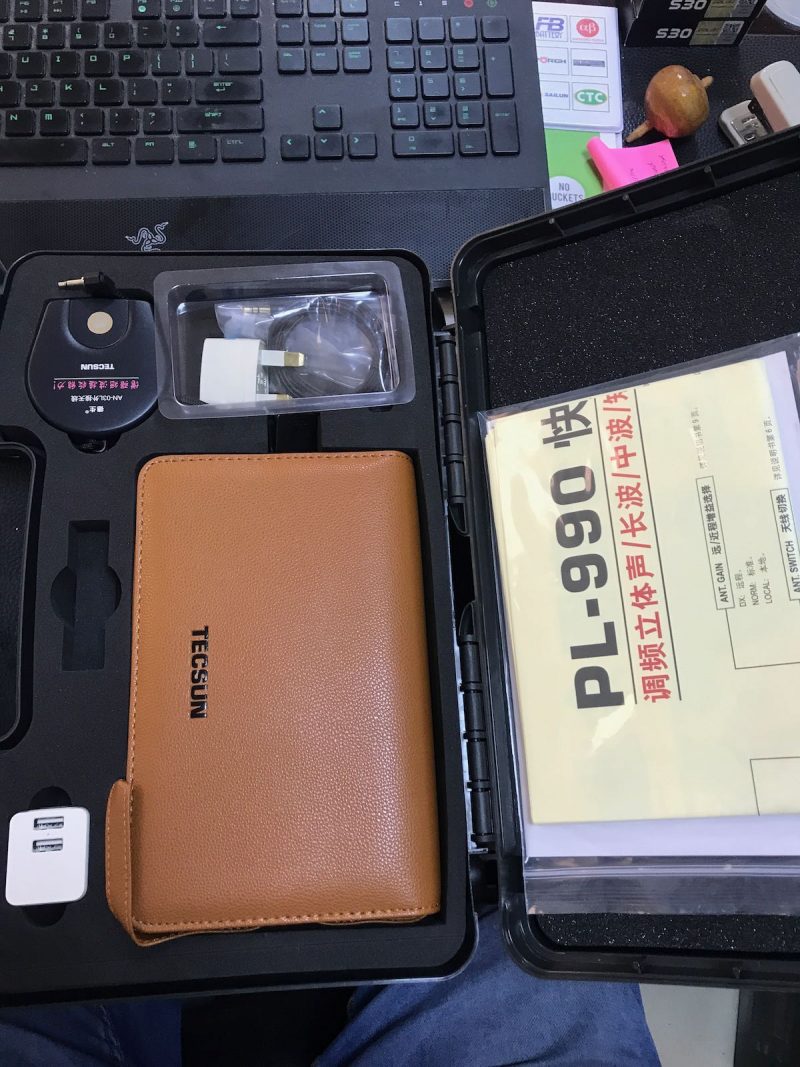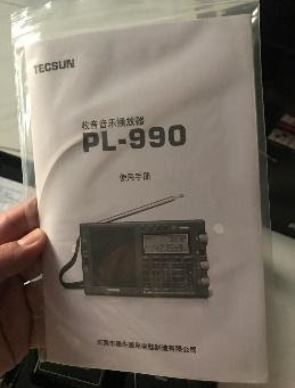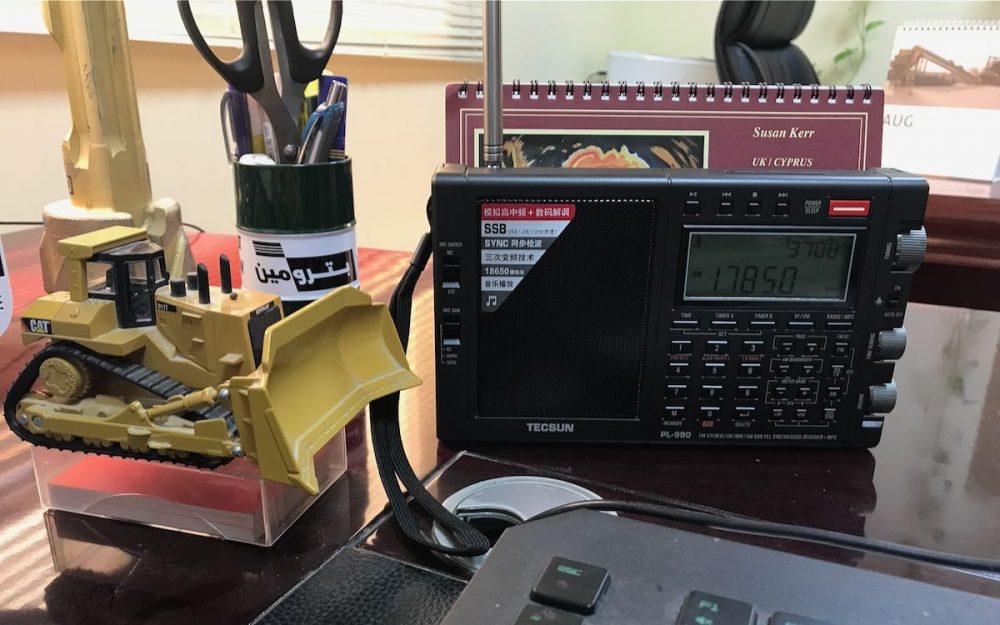The following review of the TX-500 was first published in the October 2020 issue of The Spectrum Monitor magazine.
Last year, a company out of Russia started dropping hints about a QRP transceiver they were developing called the Discovery TX-500.
The prototype photos looked like nothing else on the market: it was unusually thin––only 30mm thick––and sported a CNC-machined aluminum alloy body. The radio also featured top-mounted controls ideal for field use, and a high-contrast LCD backlit screen with a spectrum display.
Some of the initial photos of the prototype showed water droplets on the front faceplate indicating that the TX-500 would be water/weather resistant––certainly a first for the amateur radio market.
After the initial hints dropped by lab599, the TX-500 developed somewhat of a cult following among field-portable radio operators (like yours truly) as well as those into radio preparedness. However, after this tantalizing flurry of initial images, there was a lull, and very little information was available about the rig. Then in late July/early August 2020, we finally learned that the TX-500 would be sold in the US by Ham Radio Outlet. HRO’s product page posted a price of $789.95 with a projected availability date of mid-to-late September 2020.
Thus I felt quite lucky when I learned that a loaner TX-500 was being sent to me for one week to evaluate and review. Those of you who know me and read my reviews know that I typically prefer to spend several weeks with a radio before I feel comfortable enough writing a review. In this case, that simply wasn’t an option. I decided to push aside all of my other obligations and simply dive into this radio.
The following review is based on using the TX-500 in the shack and in the field over the course of seven days. During this week, I managed to activate eight parks for the Parks on the Air (POTA) program, exclusively with the TX-500. I’ve taken the TX-500 to state parks, lakes, game lands, a National Forest, and a National Park. The TX-500 experienced full-on sunshine during a long operating session, and was even rained on once.
I’ve also made a number of QSOs with this radio from home, both via CW and phone. In total, I’ve logged an average of 31 CW and SSB contacts with the TX-500 each day I’ve had it.
Initial impressions
The TX-500 looked so impressively machined and designed based on the initial photos and few videos published, I honestly feared it couldn’t possibly measure up to the expectations built up about it. Would it be the rugged radio we’d heard about? Could it travel? Could it hold up in the field, under variable conditions and in fickle weather?
With the radio finally in hand, I noted the build quality and thought to myself, This rig might just do it.
The body of this radio is absolutely solid. It’s weighty without being heavy, and there are no loose parts––no wobbly encoders, no wonky buttons, and relatively few seams or openings that might be subject to dust or water penetration. It’s rugged, sturdy––and, I must add––beautifully engineered.
The layout is simple: there’s a backlit LCD screen on the left of the radio with four function buttons above and below it. These buttons control most of the functions and features you use while operating: CW adjustments, Receive and Transmit audio EQ, Noise Reduction, Noise Blanker, CW Memory keying, A/B VFO control, and more.
To the right of the display you find a set of buttons stacked vertically that include the power button, mode, band switching, and a menu button for making less common adjustments. The encoder is raised and feels silky-smooth to operate. There appears to be no brake control, but this is not a problem because this rig doesn’t need it: it’s well-balanced and feels of excellent quality. Indeed, tuning is adaptive and fluid; I’ve been very pleased with the lab599 tuning.
There are two knobs above the encoder which adjust the AF gain and RIT. Other buttons next to the encoder control things such as the tuning steps and speed, controls lock, and memory writing.
You can tell the TX-500 was designed by an amateur radio operator because the radio is laid-out beautifully. All frequently used functions are easy to find and intuitive. There’s no need to do a deep-dive into embedded menus to, say, change the RF gain control.
There are a number of general coverage QRP transceivers on the market, so even just looking through the features and specs it’s clear how it might stack up.
This being said, the TX-500 does lack a few things you might find in other field portable QRP general coverage transceivers. We’ll start with those.
No (Built-In) Speaker
The TX-500 does not have a built-in speaker. With weather-resistance in mind, lab599 may have opted to leave the speaker out of the chassis, and instead include a speaker microphone combo with their basic package. The supplied speaker/mic is of good quality and the audio can be made incredibly loud. And, although I’m not a fan of speaker mics, I must admit this one has grown on me: in the field doing SSB, it’s much easier to bring the speaker closer to your ears when trying to work a particularly weak station.
But what about when operating CW––? In that case, the speaker mic becomes inconvenient as you are forced to port out the audio via the speaker/mic connector. It’s worth noting here that the TX-500 package being sold by Ham Radio Outlet includes an audio breakout cable so you can attach your favorite headphones or boom/mic set. My pre-production unit did not include this, so I had to use the speaker/mic and its mono audio port.
I, however, tend to operate with headphones in the field unless someone is helping me log stations. Headphones help me isolate myself from noises and distractions around me (like my dog straining on her leash, whining over her inability to chase squirrels). Headphones also improve my ability to detect and work weak signals.
When I operate CW in the field, I tend to place the TX-500 on my backpack and attach the speaker mic to the top flap. It’s worked out quite well.
Audio from the speaker microphone is tinny, but actually well-tailored for voice and Morse Code. For shortwave radio listening, however, that’s another story: you’ll certainly want to connect a proper speaker.
No ATU
The TX-500 does not include an internal automatic antenna tuner. For those used to operating an Elecraft field radio, the Xiegu G90, or the CommRadio CTX-10, for example, this might seem like a major omission.
While it would be nice to have an internal ATU, I’m quite happy to do without one, as all of my field antennas are resonant on the bands I operate. But as a point of comparison, it’s nice when, say, my end-fed antenna isn’t ideally deployed and can’t get that 1:1 match on the 40 meter band; with my KX2, I can simply push the ATU button and the rig solves the match.
I carry a simple Emtech ZM-2 balanced-line manual antenna tuner, just for when an ATU is needed. But out of the eight field activations I’ve done thus far with the TX-500, only once did I add the ZM-2 to the mix, and just to bring the match from a 2.3:1 to 1:1. If I wanted an external automatic antenna tuner, I’d grab an Elecraft T1. It’s a gem of an ATU.
No internal rechargeable battery (yet!)
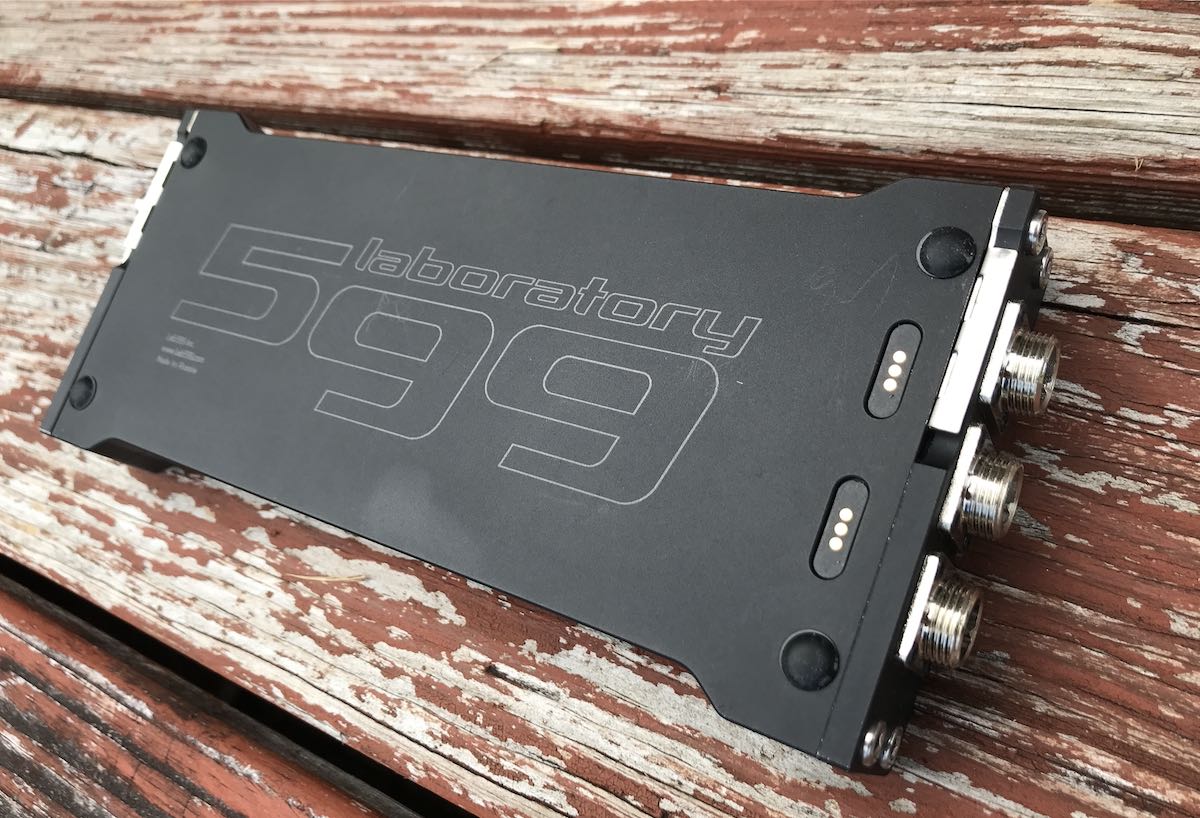 The TX-500 transceiver doesn’t have an internal rechargeable battery option like the CommRadio CTX-10 or Elecraft KX2. But like the new Icom IC-705 sports, lab599 is designing an attachable rechargeable battery pack that will fit the TX-500 beautifully. You can see the recessed battery connections on the back/bottom of the TX-500.
The TX-500 transceiver doesn’t have an internal rechargeable battery option like the CommRadio CTX-10 or Elecraft KX2. But like the new Icom IC-705 sports, lab599 is designing an attachable rechargeable battery pack that will fit the TX-500 beautifully. You can see the recessed battery connections on the back/bottom of the TX-500.
As of this time, no availability date for this future option has been announced, but I can confirm it is indeed in the works.
What makes the TX-500 unique
For some, the idea of a radio which lacks an internal speaker and ATU might lead the rapid decision to dismiss it outright. I would urge those folks to continue reading, however; the TX-500, due to some very unique features, has certainly carved out a market niche, and thus is worth the consideration.
Rugged, weather-resistant body
As I mentioned above, the TX-500 has a solid aluminium-alloy body which gives it a distinctly solid feel. There are no gaps between chassis plates, and all of the buttons, knobs, as well as the encoder are sealed to prevent water penetration.
The TX-500 design smacks of military-grade construction, but in truth is a blend of military specs and amateur radio functionality. For example, the chassis is, if anything, over-engineered for most amateur radio applications. If I owned the TX-500, I wouldn’t hesitate to take it on extended hiking trips, even in dubious weather. Of course, that’s not to say I’d intentionally leave the rig out in heavy rain. But I wouldn’t worry about a sudden rain shower ruining my radio. If this were a military radio, it would have fewer controls and likely be somewhat channelized. Instead, the TX-500 has the full set of controls, features, and filters you’d expect in an amateur radio transceiver with a military-build quality.
In short, it might appear to belong to rugged military kit, but it’s very much designed for the demands of amateur radio operators.
Although the TX-500 is incredibly solid, it’s also lightweight. I weighed the radio with its speaker/mic and power cable. The total weight was 1 pound, 7 ounces. One of my blog readers noted that such a lightweight radio would simply break in half if they hit it over their knee. My reply? No way. In fact, I’m willing to bet such an action could break your knee cap! Please don’t try this, you’ll surely regret it.
Connectors
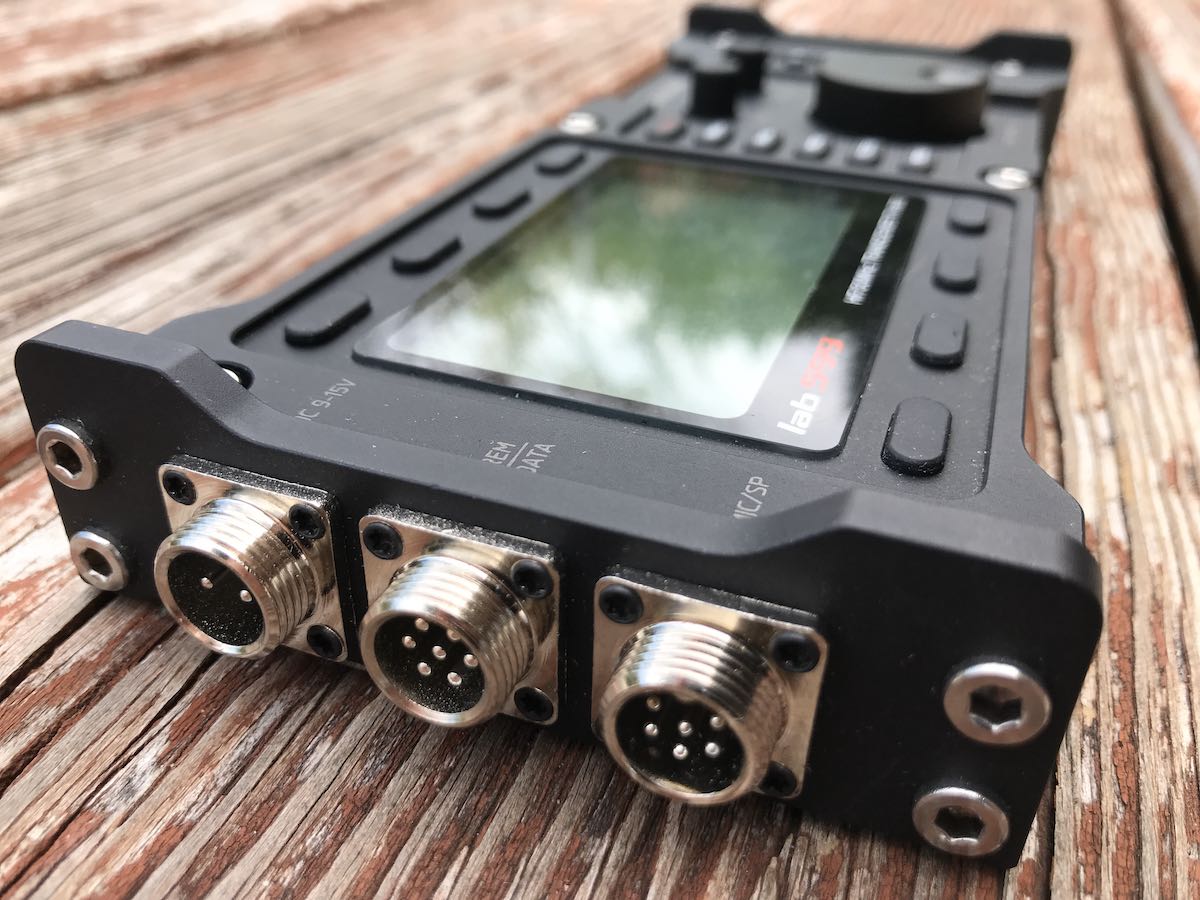 One of the most frequent questions readers ask about the TX-500 is why its makers chose to include non-standard (to radio) GX12mm multi-pin aviation connectors for the rig’s power port, CAT control, data, CW, and speaker/mic…?
One of the most frequent questions readers ask about the TX-500 is why its makers chose to include non-standard (to radio) GX12mm multi-pin aviation connectors for the rig’s power port, CAT control, data, CW, and speaker/mic…?
The answer? In brief, it’s water resistance.
GX12mm connectors allow for a watertight connection and protect the radio very well from water intrusion. And while GX12 connectors aren’t standard in the world of amateur radio, they are certainly standard in aviation, commercial, and military applications. These connectors are widely available online and there are even mom-and-pop ham radio retailers like W2ENY selling premade TX-500 cables and adapters on his eBay store and website.
Meanwhile, the TX-500 uses a standard BNC antenna connection for antennas, which I’m very pleased to note.
LCD screen with spectrum display
Most of us now expect modern SDR-based transceivers to sport a full-color backlit––and sometimes touch screen––display. In the field, however, color TFT displays can be incredibly difficult to read in full sunlight.
Like the Elecraft K and KX series radios, lab599 opted for a more simple, higher contrast monochrome backlit LCD display. This pleases me to no end, because I much prefer this type of display in a POTA or SOTA field radio just because it’s so much easier to read in bright outdoor light. Also, I feel touch screens aren’t as well suited for hiking, camping, and heavy field use–they’re more vulnerable to being damaged.
The TX-500 LCD is chock-full of information and very responsive. The spectrum display (no waterfall) is fluid and useful, as effective as any full-color display.
Benchmark current drain
When operating on battery in the field, current drain in receive mode is a major factor. The more slowly you can sip from the battery while the radio is receiving, the longer play time you’ll have. I like my general coverage field radios to consume less than 400 milliamps.
My benchmark general coverage radio, the Elecraft KX2, consumes a mere 135-140 milliamps at moderate volume levels. I can operate for hours with a compact battery. The TX-500 consumes between 110-120 milliamps at a moderate volume level; yes, even a smidge better than the KX2. The company lab599 actually specs out this radio at 100 milliamps, and I’m confident one could achieve it simply by using headphones.
While there are transceivers like my MTR-3B which have even lower current drain, they’re CW-only and lack general coverage reception, large displays, and the like. Thus, the TX-500 sets a benchmark for general-coverage full-featured portable transceivers in terms of drain.
On the air
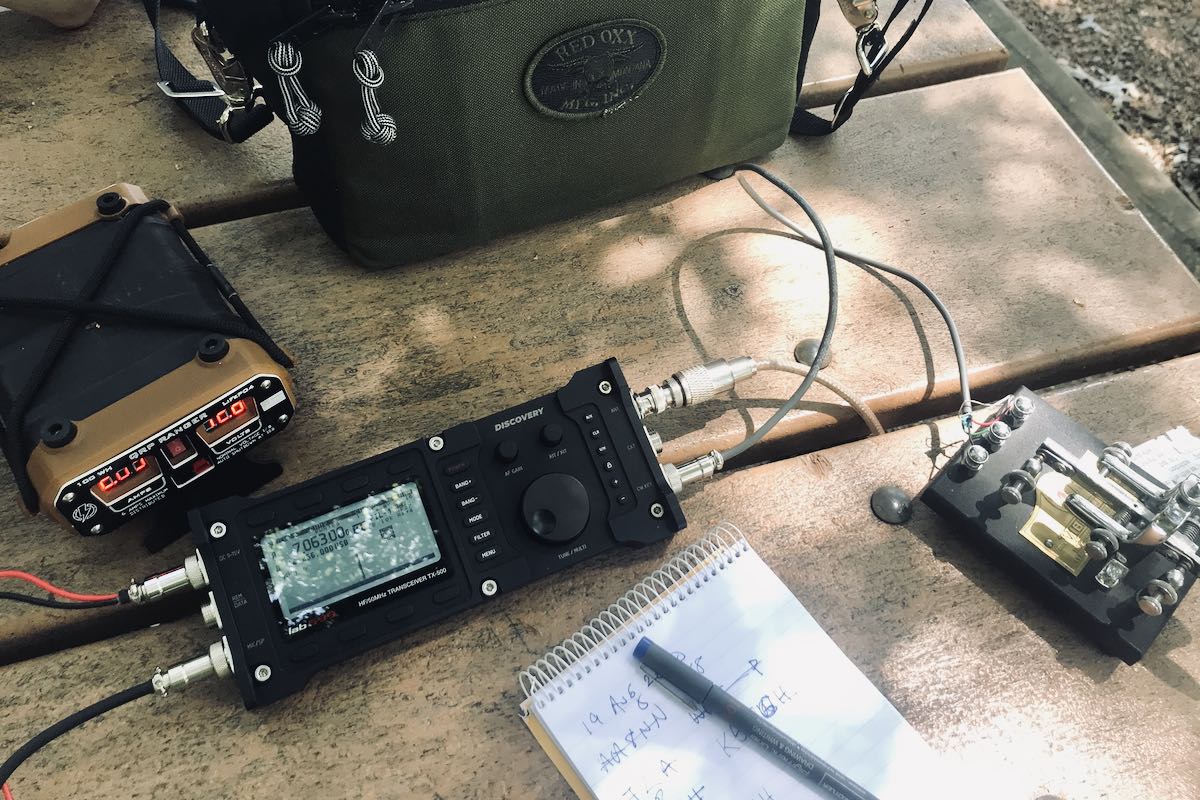 In terms of operating the TX-500 in the field, I have very few complaints. The menu system is very easy to use and is intuitive. I never needed to reference the manual––but if you do, the manual is one of the best I’ve seen from a new transceiver manufacturer (click here to download he manual and other TX-500 files).
In terms of operating the TX-500 in the field, I have very few complaints. The menu system is very easy to use and is intuitive. I never needed to reference the manual––but if you do, the manual is one of the best I’ve seen from a new transceiver manufacturer (click here to download he manual and other TX-500 files).
The buttons are easy to press. They have a tactile feel and proper response so you know you’ve properly engaged a setting. The features and buttons are well spaced, too, and the thin-but-wide chassis actually provides generous surface area for the controls. One could easily operate the TX-500 with gloves on, should it be necessary in cold climates or winter conditions.
As mentioned earlier, the TX-500 does not have an internal ATU option like the Elecraft KX2 or the Xiegu G90. For some, this will be a huge negative against the TX-500. Good internal ATUs allow operators to use a much wider array of antennas in the field–including random wire antennas–and I’ll admit that I’ve gotten quite used to having one in my KX2 and KX3. But again, to get the most signal per watt, I use resonant antennas in the field these days, so very rarely need or employ an ATU.
So how does the TX-500 play? In the following sections I’ll address putting the TX-500 on the air as both a CW and SSB operator. Note that I did not have the opportunity to test the TX-500 on digital modes––like PSK-31 and FT8––as my pre-production model lacked the necessary cables, nor was building my own possible during the week of testing.
CW
Of the (very few) videos that were produced prior to the TX-500’s release, a couple of these were made by a CW operator in Russia. Unfortunately, I was able to glean little information from those videos. I was very eager to try the TX-500 in CW mode as this has become my preferred method of activating parks for POTA.
When I received the TX-500, it did not come with the same cables that Ham Radio Outlet will include. It did, however, include the 5 pin connector for the CW port, so I simply soldered a cable and connected it to the terminals on the back of my Vibroplex single lever paddle.
This way, I was able to avoid purchasing and attaching a three conductor ?” female plug. (This intervention did mean that, in the field, my key would weigh more than the transceiver–!)
But the question every CW operator has asked me is “Does the TX-500 support full break-in QSK?” Full break-in QSK allows instantaneous transmit/receive recovery time, so that even higher speed operators can hear between sent characters while operating. This means if another op wants to grab your attention while you’re operating––or, in the parlance, “break in”––you’ll hear them in the middle of sending a word.
Unfortunately, the TX-500 does not support full break-in QSK. Instead of being based on pin diodes (like the Elecraft KX series) the TX-500 uses a relay. This means that you’ll hear a relay click each time the radio switches between transmit and receive.
In the past, I’ve reviewed transceivers in which the relay click was honestly quite loud, even annoyingly so. Fortunately, the TX-500 has such a solid and well-sealed body that I find the relay sound to be the least distracting of any relay-based transceiver I’ve tested. You can still hear it, but it’s reasonably soft. So that you can hear what I mean, in this video, you’ll hear the relay clicking when I point the camera toward the rig.
The T/R recovery time on the TX-500 is quite rapid. While I can’t hear audio between characters sent within a word, I can hear between words when the relay is set to the quickest recovery and I’m operating around 17-20 WPM. If, however, you operate at higher speeds and prefer full break-in QSK, you may wish to give the TX-500 a pass.
The TX-500 comes with a full complement of CW operation adjustments, like Iambic type, straight key, weight ratios, sidetone volume, and the like. One oddity is that it doesn’t measure CW speed in words per minute. It uses a completely different scale that measures with a much wider number range. I set my speed to “97,” which I guessed might be an equivalent of about 17 or 18 WPM. While I first thought this feature odd, I soon came to appreciate this specificity because without the restriction to 1 WPM increments, as with most transceivers, it gives the op more flexibility to adjust speed.
I discovered that the TX-500 can handle dense RF environments while doing a park activation during a CWT contest. Even with a 400 Hz filter engaged (and it could have been much narrower), the TX-500 effectively blocked adjacent signals. To demonstrate, I made the following short video in the field:
Rob Sherwood recently tested the TX-500 and published the results on his excellent receiver test data table. Although very respectable, I expected the TX-500 to sport more competitive numbers based on my “real-world” tests. Still: this is a field radio. Not a rig I’d reach for to win the CQ WW contest. In field operations, TX-500 is a brilliant performer and has better overall specs than a number of popular radios including the immensely popular Yaesu FT-891, for example.
CW ops should keep in mind that the TX-500 has no internal speaker, so to operate you’ll either need to connect an external speaker, the supplied speaker/mic, or headphones. Since I primarily operate with headphones, this will be no inconvenience to me. As there was no headphone connector with this pre-production model TX-500, I simply used the speaker mic for all operations.
When the TX-500 was first released and HRO made a product page on their website, the rig had no CW memories, which I truly rely on for field operations. CW memories allow me to manage my logging workflow, pre-format responses, and CQ calls without having to manually key everything. Lab599 must have noted this omission, and by the time I received my evaluation unit, a firmware release had been issued which added CW memories. I immediately performed a firmware update (a simple process, by the way). I even passed along some suggestions and critiques of the CW memory keyer; lab599 immediately made adjustments and fixes as needed for optimal performance.
If you’ve ever saved CW memories in a radio, you may have found it frustrating to achieve the right spacing for the radio to provide a proper playback. It often takes me multiple tries, for example, to save a park number into my KX2. The TX-500, fortunately, is very forgiving and I found it very simple to set CW memories in the field.
While not on the radio I used at time of evaluation, I understand lab599 is planning to add a “beacon mode” for calling CQ, as well.
All in all, I find the TX-500 a pleasure to operate in CW mode. Indeed, 75% of all of my logged stations were made in CW mode.
Speaking of which, funny story…I activated Pisgah National Forest and the Blue Ridge Parkway in the mountains of western North Carolina. I hammered out 13 logged stations from Maine, Vermont, Ontario, Illinois, Kansas, Louisiana, Florida, and several states in the middle of that footprint.
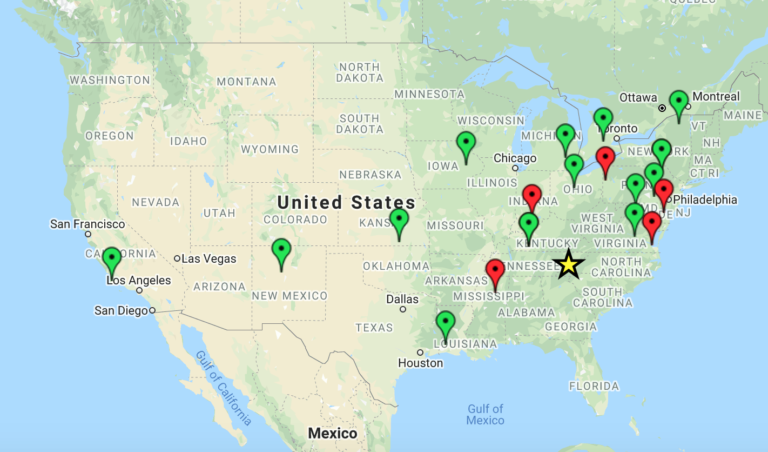
On this map, all of the green pins below were CW contacts and made with one watt of power. The red pins are SSB contacts with 10 watts. The yellow star is roughly my location:
I switched to SSB mode to make a few phone contacts, and called CQ. No one heard me. I was puzzled…but suddenly I realized I had left my power setting at 1 watt! The previous day, I was running tests into a dummy load. Yes, all of those CW contacts were made with truly low power, indeed!
SSB
The TX-500 has a lot to offer the SSB operator. I’ve gotten great reports from my SSB contacts, and have even listened to my own signals via the KiwiSDR network.
The TX-500 includes all of the features a phone operator would expect, such as compression and gain control. Of course, you can enable VOX operation if you’re using your favorite boom headset. The TX-500 allows you to not only to change the receiver EQ settings, but also transmit EQ settings. This means you can tailor your TX-500 to get the most audio punch per watt while operating phone. Very nice!
The TX-500 ships with a rugged, simple speaker microphone. I’ve been using this exclusively during the evaluation period, and have been very pleased with it. The mic even has a protected mono audio out port on the side, should you wish to attach a different external speaker.
Perhaps the only negative from my point of view as a phone operator is that the TX-500 lacks a voice memory keyer. While it has this feature for CW, it lacks it for SSB.
UPDATE – February 4, 2021: lab599 has just added voice memory keying in their latest firmware update! The TX-500 now has two voice memory memory slots of 20 seconds each: VXM1 & VXM2. After performing the firmware update, it’s easy to record voice memories:
- Navigate to CW memory menu.
- Press and hold VXM1 or VXM2 to record. REC icon on.
- Press the associated VXM key again to stop.
- Press VXM key to Play. PLY icon on.
- Press VXM key to stop.
To put this in context: all recent Elecraft rigs have voice memory keying; the new IC-705 includes this as well. Even the Yaesu FT-891, which is one of the most affordable compact transceivers in the Yaesu line, has voice memory keying. For POTA and SOTA activators, voice memory keying is huge, as it frees you to do other things like log, eat a sandwich, or talk to others while calling CQ. It also saves your voice. For example, on the KX2, I record a CQ message like “CQ POTA, CQ POTA, this is K4SWL calling CQ for Parks On The Air;” I save the message to memory location #1, then play it back in “beacon mode.” The KX2 will continuously transmit my voice CQ message with a few seconds between each call. When someone answers my call, I can easily pause the beacon by hitting the PTT switch or one of the transceiver keys.
I do wish the TX-500 had this handy feature, but because of a lack of internal storage, I don’t expect it will be added. This isn’t a deal-killer for me, as I could add an external voice memory keyer, but it certainly would make for ideal SSB field-radio operating.
Shortwave broadcast listening
Of course, since I’m a hardcore shortwave radio listener and the TX-500 has a general coverage receiver, I did quite a bit of casual shortwave radio listening during the week I had the radio in the shack.
What’s great about the TX-500 is that it has a very capable receiver with a low noise floor and superb sensitivity and selectivity. The preset filter bandwidths can be adjusted in all modes including AM. I have the widest setting at 10 kHz, which gives one proper fidelity with strong shortwave broadcasters.
Here’s a link to a quick video I made showing how the TX-500 sounds while tuning around the 31 meter band. Note that the amplified speaker I use for this demo is limited in fidelity and I recorded this using an iPad. Still, I think you’ll get a decent idea how well the TX-500 plays as a shortwave receiver:
The TX-500 will tune to the bottom of the AM broadcast band as well, and I’ve spent time listening there. I did not have the time to do a deep dive, but I find that the TX-500 performs rather well in those low bands…a rarity for a ham radio transceiver.
Summary
Every radio has its pros and cons. When I begin a review of a radio, I take notes from the very beginning so that I don’t forget those initial impressions. Here’s the list I created over the time I’ve spent evaluating the TX-500.
Pros:
- Solid, rugged chassis with weather/water resistance and built-in low-profile side protection panels
- High-contrast LCD display that’s responsive and easy to read in the field
- Excellent receiver sensitivity, selectivity, and low noise floor
- Full complement of features and adjustments expected in a modern transceiver
- Multiple adjustable filter settings
- Very low current drain for a full-featured general coverage transceiver (100-120 milliamps)
- GX12mm connections provide further water protection (see con)
- CW memory keying
- Easy firmware upgrades with supplied USB cable and lab599 firmware application
- For US customers: a Nevada-based service center for repairs (no word yet on similar centers elsewhere)
- Per lab599 announcement, hopefully available next year: an attachable TX-500 battery pack
Cons:
- No built-in speaker
- No internal ATU option
- No full break-in QSK CW operation (although relay is quiet and audio recovery fast)
- GX12mm connections are non-standard on amateur radio transceivers for water resistance, thus one might need to purchase or build cables for non-standard accessories (see pro)
No voice keyer for phone operationUpdate: this feature was added in the February 4, 2021 update!No notch or auto-notch filters at time of publication (these may be implemented in future firmware upgrades)It does indeed have a notch filter now!- Fold-out feet could scratch soft surfaces, such as wood
Conclusion
Would I buy the TX-500 myself? Well, since I’m a heavy field operator, yes, without hesitation. Moreover I believe the $800 price tag is reasonable for a radio with its feature set and rugged military-spec type design.
I confess, I have been looking forward to getting the TX-500 in hand for a year now. So when HRO put up a product page and started accepting orders, without much thought, I placed mine. Yet within an hour, I was rethinking my decision, and soon I called to cancel it. Why? A bit of buyer’s remorse. For although instinct told me I’d like the rig, common sense said I was getting ahead of myself. The truth was, at that time the TX-500 didn’t have CW memory keying, and without that, I knew this field radio would not get a lot of use during my park and future summit activations. Moreover, I’ve no less than six eight QRP transceivers––not to mention an Icom IC-705 on order for review––so it wasn’t as though the need was great. Instinct or no, I felt I’d made the decision in haste, and my head said my heart should take a few beats before committing.
Yet, after receiving the TX-500 loaner, and taking it to the field––and, of course, lab599’s addition of that all-essential memory keying––all of a sudden the TX-500 became much more appealing. And I’ll admit, this radio really grew on me over that evaluation week (ah, the dangers of reviewing radios…you do often become attached). There’s also been comfort in knowing the TX-500 wouldn’t be harmed should I be caught in a pop-up shower and anxious for the safety of my equipment. But there’s something more: it turns out my initial instincts were correct. I just happen to really like this radio. The way it feels and functions suits me as an operator and its performance exceeds expectations. And that’s a thing I couldn’t have known until I gave it a spin.
While no radio is perfect, I nonetheless suspect the TX-500 will gather a loyal customer base soon; indeed, it had a following well before anyone laid hands on it. Including me.
So now I am seriously considering purchasing the TX-500 for keeps.
Click here to check out the lab599 Discovery TX-500 at lab599.
Click here to purchase a TX-500 from HRO.
Check out W2ENY’s TX-500 cables and adapters on his eBay store and website
Do you enjoy the SWLing Post?
Please consider supporting us via Patreon or our Coffee Fund!
Your support makes articles like this one possible. Thank you!

